redwood
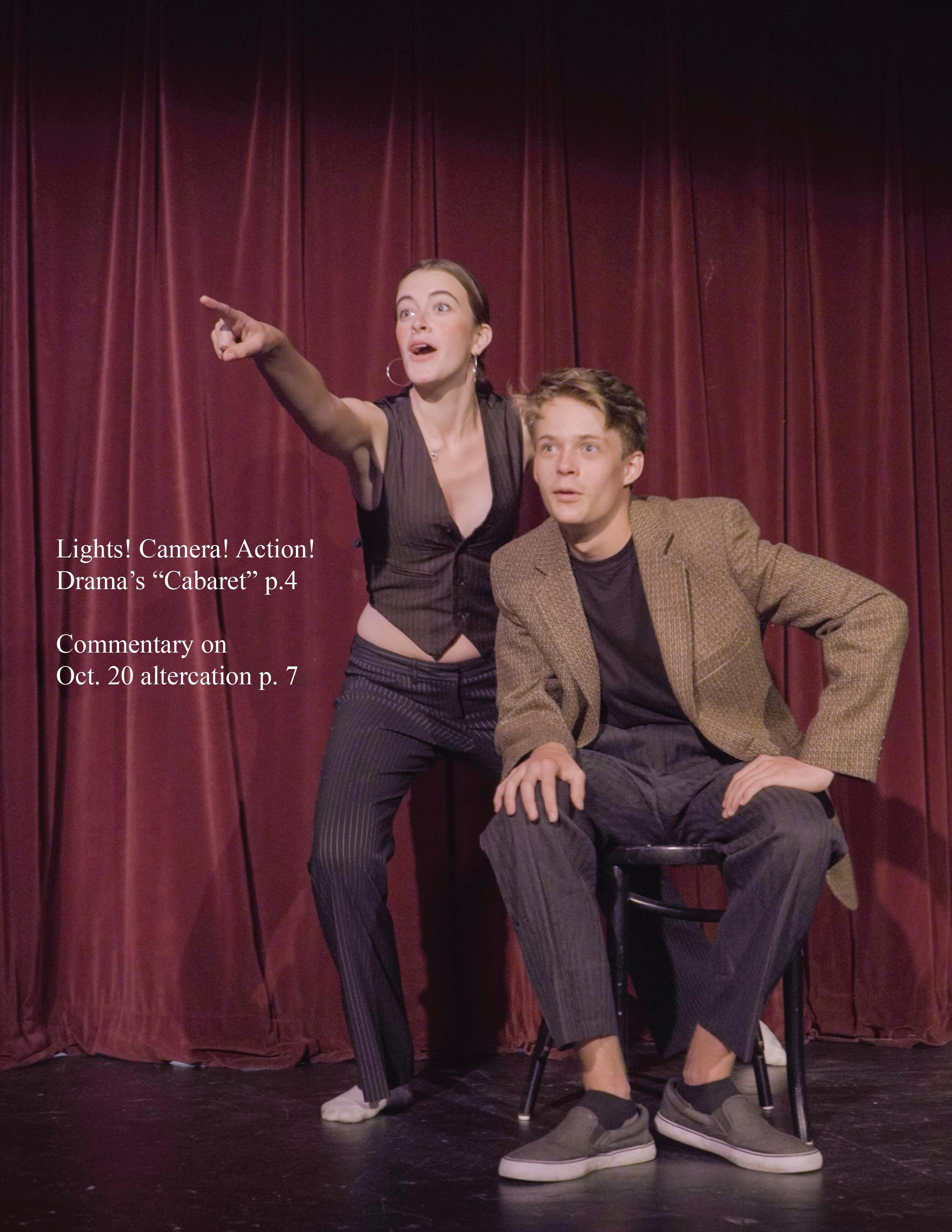
 Photo by Aanika Sawhney
Photo by Aanika Sawhney
bark. Volume LXV, No. 2 • October 28, 2022 • Larkspur, CA
g 395DohertyDrive,Larkspur,CA94939 www.redwoodbark.org
Editors-in-Chief:
CopyEditors:
OpinionEditors: ChloeBishop StellaBennett(HeadCopy) EricaBlock KellyChuang EllaKharrazi(HeadCopy) JuliaFrankus SamKimball AlexCoe ShylaLensing EllaErwig GemmaFavaloro
FeatureEditors: JustineFisch AvaRazavi MiaGinsburg DaniSteinberg
ArtConsultants: JordanKimball CarsenGoltz SabrinaKizer CallaMcBride SofiaRuliffson
LifestylesEditors: AnnaRoyal RoriAnderson MayaWinger EmilyBlock
BusinessManagers: ColeSeifer Reporters: WyattTurkington SawyerBarta ElsaBlock
SportsEditors: BenChoucroun CocoBoyden
MultimediaEditor: EmilieErickson IngridHoutkooper SarahGoody GraceGehrman
SportsEditor on Call: CharlotteFishburne ArjunAujla PashaFooman LiliHakimi
SurveyManager: HannahHerbst AniSvendsen SydneyJohnson NewsEditors: AndieJohnston MatthewMarotto GilLadetsky AanikaSawhney HarrisonLapic NewsEditor-on-Call:
SocialMediaManagers: LaurenPoulin LilyReese SophiaBuckholtz BowenRivera CamerynSmith GabriellaRouas MichaelSeton MaddieSofnas
ReviewEditors:
PodcastEditor: SamSumski KateDeForrest CaitlinBeard BellaWagner ClaireSilva KylerWang
VideoEditor: MaysonWeingart WillParsons NatalieWelch
WebDeveloper:
SpanishEditor: AidanCarney Skytt GillianReynolds

redwoodbark
Fentanyl takes a dangerous, multi-colored form
By Sam Sumski
On Sept. 28, the Drug Enforcement Administration (DEA) seized 15,000 multicolored pills in New York City. These pills, stored in LEGO boxes, were imprinted with “30 M,” indicating 30 milligrams (mg) of oxycodone hydrochloride — despite actually being laced with fentanyl.

In an ABC interview, Bridget Brennan, New York City’s Special Narcotics Prosecutor, indicated the visual similarities between the pills, known as ‘rainbow fentanyl,’ and candy. Brennan emphasized the importance of spreading current and accurate information to the public about this new form of fentanyl that is being distributed.
“This investigation uncovered a trove of dangerous rainbow fentanyl pills worth up to $6 million on the street, plus an estimated $3 million in powdered fentanyl,” Brennan said.
The price of the pills is not the only staggering aspect of the drug, as many local families have been affected recently. Ed Ternan is the father of Charlie Ternan, a 22-year-old college student who lost his life in 2018 due to fentanyl-laced Percocet, a pain medication that he used to self medicate. Ed has since dedicated a great quantity of time and effort to educating the public on the dangers of the drug.
“[Charlie] never had a chance. He died within 30 minutes,” Ed said. “There is no way to get around it. Over the last few years, fentanyl has taken over and dominated the drug deaths in this country.”
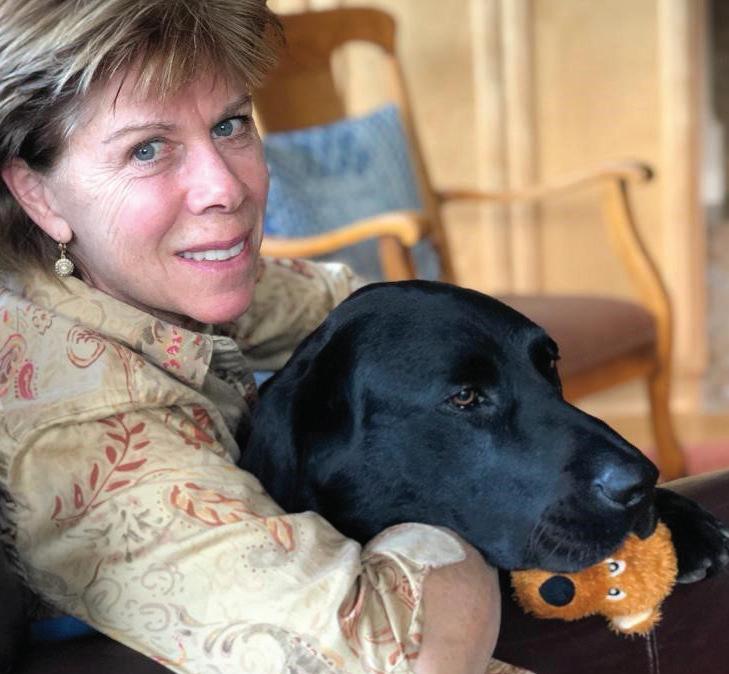
On Oct. 6, the Let’s Talk Workshop Series began with its first discussion of 2022: Just Say Know. The discussions, started in 2020, are run by Jackie Davis (event moderator and speaker) and have provided essential knowledge to the community. Redwood families were invited to watch and
Photo courtesy of Audacy join the meeting, where impacted individuals including Ed, spoke on the issue.
Following the passing of his son, Ed created an organization called “Song for Charlie,” which shares Charlie’s story, the dangers of fentanyl and how to get involved in spreading awareness. Ed has found that there are astounding numbers of young adults that do not know the dangers of fentanyl.

“The rainbow version [of fentanyl] is not about killing children — the Mexican cartels are in it for the money and product line extension, getting a party pill arena and a broader market to introduce more customers,” Ed said.
Fentanyl is also much cheaper to produce than other drugs because it does not originate from a plant; it is produced in labs from chemicals.
The Redwood Wellness Center Outreach Specialist, Magdalena Maguire, explained the plan the Wellness Center is creating with programs at Redwood spreading awareness of dangerous drugs and educating students on
the harmful effects of just one pill.
“Fentanyl came in like a bomb, and we are trying to react as best as we can to show our school community how dangerous it really is,” Maguire said.
Maguire emphasized that rainbow fentanyl is at the center of the public eye, and parental awareness, from asking questions to attending meetings like the Let’s Talk Workshop Series, has great value. This is vital to preventing further deaths and overdoses.
“Parents have the right to be worried about their children and the dangers of rainbow fentanyl. Educating our students and children is the best way that we can prevent rash decision making when it comes to purchasing pills off of the street,” Maguire said.
Students live in a very different world than their parents, and it is clear that with social media, teenagers are exposed to more drugs than ever before. The National Survey of American Attitudes on Substance Abuse found that 40 percent of surveyed teens had seen pictures of kids abusing drugs or alcohol on social media.
Psychiatry specialist Jeffrey DeVido, from the University of California San Francisco, shared the neurological effects of fentanyl that he has been studying.
“We as humans are hardwired to take risks, so it is essential that we assess the situation and take risks with low consequences,” DeVido said.
However, fentanyl has created an off-the-street drug market that can be extremely dangerous and consequential.
“Any pill that is bought off of the street is subject to having fentanyl in it” DeVido said.

For now, spreading the word about rainbow fentanyl, its risks and Naloxone, a nasal spray that reverses a drug overdose, are the most important steps in combating its effects.
ssumski@redwoodbark.org
Freshman class transitions from standards to letter grades
By Dani Steinberg
On Aug. 17, 2022, the first day of Redwood’s 2022-2023 school year introduced the incoming class of 2026 to letter grades. After nearly three months of assessment on the 100-point letter grading scale, freshman students have undergone significant adjustments from their middle school grading system.
The four most prominent feeder schools to Redwood — Hall, Del Mar, Ross and Kent — now collectively utilize a different
grading system from the Tamalpais Union High School District (TUHSD). Their alternate systems, which are known as standards-based grading, assess students on a 1-4 or 1-3 scale, unlike Redwood’s current A-F scale.
According to the principal of Hall Middle School, Toni Brown, the standardsbased form of grading aims to encourage students to pay closer attention to the content they are learning as opposed to solely focusing on receiving the highest grade.
“A through F [grading] does not intrinsically motivate students the same way a goal-oriented type of mastery would,” Brown said. “We are on a 3-tier scale — ‘Approaching,’ ‘Proficient’ and ‘Emerging.’ The goal is to be able to have students independently and consistently demonstrate to [teachers] that they understand [the material] and are proficient in the standard.”
In addition to focusing on the content at hand, this alternative, standards-based grading system supports the reduction of student stress. Students are given more opportunities to demonstrate their understanding of the course material.

“There is definitely less anxiety around grades, and there is more of an understanding of, ‘I can revise my work and resubmit.’ When teachers give that feedback, it is all about that process; it is all about [students] improving their work,” Brown said.
understanding. Similar to Brown, Stuart finds this new grading system to be a more accurate representation of a student’s knowledge of a topic.
“Standards-based grading takes the game play out of [school]. … Somehow in society we condition kids to want to do the assignment because of the point value,” Stuart said. “The main [benefit of standards-based grading] is that [teachers] get away from students asking [them], ‘What do I need to do to improve my grade?’ or, ‘How much work do I need to do to get an A?’ More of the questions are, ‘What do I need to do to show growth in my learning?’”
However, Del Mar graduate and freshman Renata Lionetti feels that standards-based grading did not prevent student stress and instead redirected students to alternative ways to reach the highest possible standard. Instead of working to receive an A+, students aim for an “Advanced,” the highest standard possible.
“[Standards-based grading] made me always want to get an ‘Advanced,’ and I think Del Mar in general, academically, was intense, especially [in] eighth grade. … Sometimes I would get mad if I didn’t get ‘Advanced,’ and I put a lot of pressure on myself,” Lionetti said.
problems. However, Stuart considers any student who understands themself a learner and has experienced growth to be capable of thriving academically after middle school.
“Our students here at Del Mar will be successful because they know how to learn; they know what growth looks like,” Stuart said.
Brown is also not concerned about this year’s freshmen transition to letter grades in high school.
“If we are doing our job right with standards-based grades, [students] have demonstrated proficiency, so having them transition to [letter grades] is not something I am worried about,” Brown said.
Despite claims of eliminating pressure and producing more proficient learners, Hall graduate and current freshman, Henry Smith, did not experience those benefits and wishes he had been receiving letter grades throughout middle school.
“[The alternative grading] was nice while we had it, but now [the levels of proficiency seem inflated in comparison to their corresponding letter grade] — an ‘Approaching’ felt like a B, but now it is a C or a D. … It would have been nice to have a normal grading system, so it’s the same throughout middle school and high school,” Smith said.
by
Del Mar’s principal, Chad Stuart, is also an advocate of using standards-based grading. After 13 years in the TUHSD, he has seen firsthand how letter grades can negatively affect student growth and
Despite efforts to mitigate the pressure on students to reach the highest standard and do work focusing on the material instead of grades, it seems that both letter grades and standards-based grading have the same outcome for students.
Additionally, the transition from standards-based grading to letter grades when starting high school poses its own
Standards-based grading’s levels of proficiency are not intended to be translated to letter grades. However, in high school, the reality freshmen face with a new system and its challenges offers a sharp contrast from what they are accustomed to.
redwood high school ● 395 doherty dr., larkspur, ca 94939 ● volume LXV, no. 2 ● october 28, 2022 ● www.redwoodbark.org . 14 Best
hikes in Marin
17
Wellness Specialist
23College: Then and
Now Marin’s Bakeries
Substitute
Teachers
Volume LXV, No. 2 • October 28, 2022 • Larkspur, CA
REMOVED FROM LEGO boxes, rainbow fentanyl was seized from cars in New York City.
Infographic
Sarah Goody
dsteinberg@redwoodbark.org
Photo Survey
$400 million district modernization plan advances
By Michael Seton
The Tamalpais Union High School District (TUHSD) has ambitious plans to modernize its aging campuses amidst declining enrollment. On Nov. 15, the district’s Board of Trustees will select an architectural firm to begin design work on proposed changes to Redwood’s campus. These changes are identified in the district’s Facilities Master Plan (FMP), which was developed by Corbett Elsen, Assistant Supervisor of Business and Operations for the TUHSD. The plan reflects the involvement of various consultants, the district’s Board and numerous members of the community.
The project includes a number of items, most notably the demolition of over 8,000 square feet of existing buildings, including many portable classrooms, due to their deteriorating condition.
“The portable classrooms are about 3040 years past their lifespan,” Elsen said. “They need to be replaced for structural reasons.”
The plan also proposes the construction of a new two story arts building, a new music building and a new cafeteria and kitchen. Art teacher Bradford Butler explained the limitations of the existing art building.
“While our [ceramics] equipment is incredible, the integrity of the building could definitely use some work,” Butler said. “There is water leakage, insulation issues, some ventilation problems and very old air conditioning and heating units that continue to be replaced. The building that I am in was never meant to be permanent.”
The architects will also repurpose the kitchen into 9,000 square feet of flexible
collaboration space, designing 6,700 square feet of interim housing and incorporating the related American Disabilities Act (ADA) and site improvements associated with these changes. The preliminary construction cost estimate for all this work is $47 million.
A Redwood Site Design Team, involving a parent, a student, an administrator and four staff members, including Assistant Principal Saum Zargar, will be selected by early November to vet the designs and provide feedback to the architect and design team.


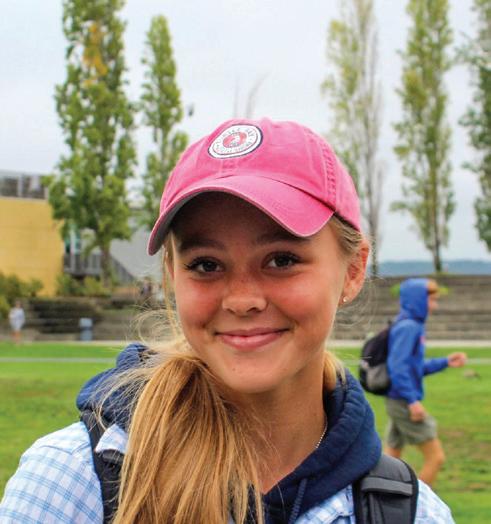
Not all of the proposed changes will occur at once. Instead, they have been prioritized as “must-do” items, “shoulddo” items and “would-like-to-do” items.
Top projects for Redwood include legally required ADA improvements, irrigation
enhancements, roofing improvements and utilities upgrades, as well as mechanical, electrical and plumbing upgrades. Zargar supports the emphasis on these items.

“I am in agreement with the FMP, in that looking at our heating, ventilation and air conditioning units is important given that we’ve [recently] had smoky days and hot temperatures,” Zargar said.
Projects that are second priority are access control, asphalt repair, athletics improvements, building replacements and solar and cogeneration energy efficiency improvements involving new photovoltaic canopies and electric vehicle charging stations. The lowest priority items are athletic enhancements, portable classroom replacements and an upgraded student wellness space.
The TUHSD’s current facilities fundings of approximately $12 million does not cover the needs identified by the FMP. The upgrades for Redwood alone are estimated to cost $148 million. The districtwide project is anticipated to be $394 million in total. This amount includes an 11 percent buffer for unexpected additional future expenses such as inflation. Just the top priority projects would amount to approximately $250 million across the district and $28 million for Redwood. Elsen defended the large size of the project.
“We’re not building the Taj Mahal football stadium, [and] we are not building a five-story cafeteria,” Elsen said. “We are doing things that are reasonable and needed. Given that, we think our community will likely support it.”
To pay for this project, the TUHSD is planning to issue a large bond in 2024 which will require 55 percent voter approval. The current bond supporting the TUHSD charges homeowners $21.48 per $100,000 of assessed property value. This assessment is declining each year and will expire in 2032. If the district issues a new bond in 2024 that continues this assessment at the same level, it will raise $254 million
at current interest rates. This amount is far short of the approximately $400 million the district is likely to need for this project.
One alternative would be to issue a new bond that increases the existing tax from $21.48 to $30 per $100,000 of assessed property value. This would raise $418 million, covering the entire project but allowing for only 17 percent of cost overruns. A third option presented at the April 12, 2022 district Board meeting was to add $30 to the existing tax, totaling $51.48 per $100,000 of assessed property value, to raise $475 million in total. This $51.48 assessment would decline to $30 per $100,000 of assessed value by 2032 when the existing bond expires.
Because the Board wants to ensure the successful passage of this bond measure in 2024, Elsen suggested they may reduce the project’s size by eliminating the priority three items. A $328 million assessment of even lower priority costs, mainly interior and exterior upgrades, has already been excluded from the FMP. Although removing priority three items would reduce the size of the project by only $11 million, it might be necessary since the TUHSD has not had consistent voter support. For example, in March 2020, the TUHSD’s parcel tax extension failed to attract the 67 percent voter support it needed to pass.
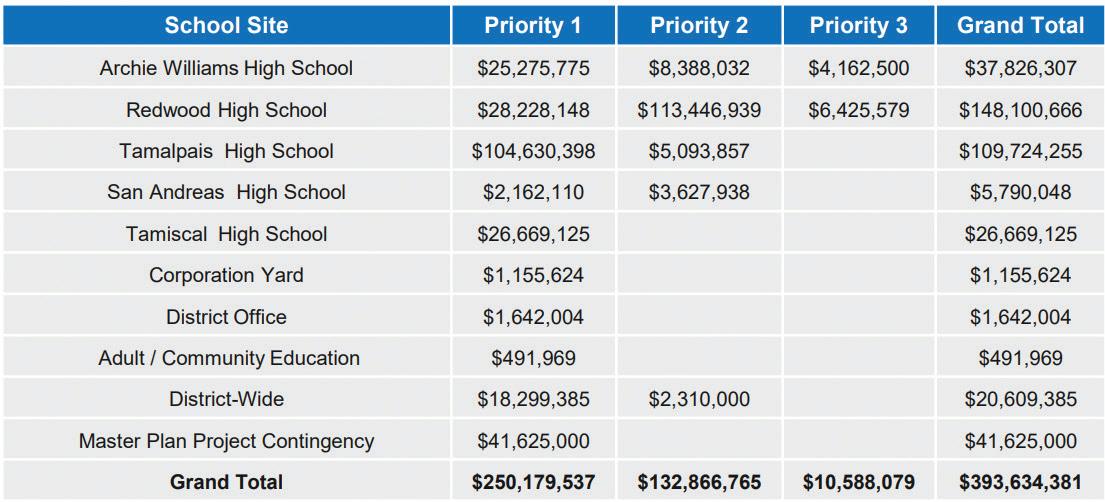
“I really hope we can bring this [project] to fruition,” Elsen said. “What it will do for students and staff is awesome.”
Butler believes the new buildings are critical to the future success of Redwood’s art program.
“A permanent space would increase the quality of this studio tenfold,” Butler said. “Introducing a building that would accommodate a higher level of craft in ceramics and sculpture would increase the quality of the program by introducing students to opportunities that higher education provides.”

bark Page 2 • News October 28, 2022
“In the sixth grade, I put together a surfer costume [the night before Halloween] and made a cardboard surfboard.”
“When I was younger I was a vampire four times. I like it because it’s unique and looks cool.”
“When I was six, my mom forced me to be a lion but I was too scared of the costume. I chose to be Thomas the Train.”
“My favorite Halloween costume was when my friends and I dressed as bananas. My other friend [was] a monkey and chased us around.”
Brody Guerro senior Abby Skov junior Beckman Watrous sophomore
“What is your favorite past Halloween costume?”
Hannah Lacey freshman
Graphic courtesy of TUHSD
REVEALING THE EXTENT of infrastructure damage and wear at Redwood, these photos were presented to the district’s Board.
Images courtesy of TUHSD
mseton@redwoodbark.org
YouthTruth annual survey reveals student perceptions
For the second year, the Tamalpais Union High School District (TUHSD) and YouthTruth, a national nonprofit, are partnering to survey thousands of students, staff members and parents. The surveys, being conducted throughout October, collect vast amounts of data via anonymous, digital questionnaire responses. This comes as a recent YouthTruth review of 220,000 students found that over 50 percent “cited depression, stress and anxiety as an impediment at school,” and that 14 percent of high schoolers “seriously considered suicide.” Facing the reality posed by these responses, it is more important than ever that schools identify and understand today’s problems. That is the main objective of this year’s survey, which is led by Assistant Principal Lisa Kemp.

“[The survey] is about conversations on how kids feel about school, whether they feel safe and whether they are motivated. What do teachers do that’s effective [and] not effective?” Kemp said.
With staff and family surveys, Redwood’s data collection effort involves a three-pronged approach. Once compiled, the feedback undergoes an extensive review as YouthTruth creates a report that compares responses to nearly 2.5 million students and half a million staff and family surveys from 39 states. Assimilating this database to Redwood’s tens of thousands of data points is no easy task, but one that Jennifer de Forest, YouthTruth’s Director
Cathleen Acheritogaray
Christy & Rob Acker
Julie Alexander
The Alioto Family
Susan & Mark Anderson
The Aujla Family
Benjamin Bank
The Barker Family
The Barta Family
Allison & TJ Belger
The Bennett Family
Debbie & Shawn Bennett
Stephanie Bennett
The Berger Family
The Bishop Family
Angie Block
Elsa Block
Loren Block
Fred & Mary Blum
Kathleen Beaver Brady
Casey Braff
Robert Britt
Donal & Brenda Brown
Ruth Krueger & Kevin Buckholtz
Kristi Burlingame
Carolyn Calfee & Gerard
Choucroun
Negrea Camelia
Frank Cardinale
Michele Farnsworth
The Fisch Family
Dipa Cappelen
The Carlson Family
Sarah Centeno
The Cico Family
Greg & Karmela Cleary
David Coe Ed Conti
Hali & Eugene Croner
Simone & JJ Davis
The Desin Family
propose in terms of changing curriculum.”
This process, along with the implementation of the surveys, is aided by Heather Smith, a partnership lead at YouthTruth, who collaborates with schools to ensure ideal outcomes.

“[I] work with districts to show the importance of student, family and staff voices in being central parts of district plans for their upcoming school years and beyond,” Smith said. “After [the survey], I [look at] what students are saying and talk about how this can be brought into planning.”
One of this years survey takers, junior Jake Gotlieb, completed it with the majority of students on Oct. 18.
“Schools [often] don’t listen enough to the feedback of actual students, teachers and parents, [but] having the survey [allows] the district to know a school population’s morale [and] certain demographics,” Gotlieb said.
Gaining student input is backed by scientific research, too, with a 2018 study of medical students finding, “Academic achievement was significantly related to higher scores for perception of teaching, perception of atmosphere and social self-perception.” Considering this, Kemp values the continued use of YouthTruth surveys.
of Organizational Learning and Communications, considers essential to school success.
“I work on the research to gather insights out of the data, to look at the trends across the country, so that you can think what’s going on in Marin. Is this what we’re seeing across the country? How is it different depending on what your background is? Then, we give all of that information back in reports to principals and superintendents so that they understand what’s going on,” de Forest said.
Important takeaways from last year’s survey of over 1,500 Redwood students revealed that only 54 percent of students consider themselves part of the school community. Other findings indicate that classwork makes 58 percent of students “really think” and that a majority of students do not consider curriculum helpful outside of the classroom. For Kemp, addressing and adapting to these student perceptions is made possible by the surveys.
“Curricular decisions are tricky,” Kemp said. “We have to sell the idea of updating courses … [so] we need the data to back up what administrators and teachers
Bark Patrons
Melissa Dickerson
Robby & Zach Dinowitz
The Donehower Family
Natasha Drucker
Naz Erickson
Matt & Sara Eslinger
Joseph Estus & Veronica Skelton
Sid P. Ewing
Maya Farhoud
Michele Farnsworth
Monica Fieber
The Fishburne Family
Cathy Flores
Paul Gehrman & Norah Frei
The Gerber Family
Jennifer & Mike Ginsburg Marcy & Don Ginsburg
The Goldstein Family
John & Kathleen Goodhart
The Gouloomia Family
Thomas Haan
The Hackett Family
The Hafez Family
Gary & Melissa Harms
Jennifer & Dennis Harrison Gail & Jason Hartka
The Hartung Family
Megan Harvey Randy & Tom Herbst
Mark Hewlette
Matt & Megan Howard
Charlene Ip
Amira Iskander
The Jacobs Family
Sylvia Jones
Crockett & Kate Jeffers
The Kharrazi Family
Jon & Janie Kimball Laurie & Louis Kimball Linda & Tom Knauer
The Koblik Family Eliza & Mike Koeppel Carl & Jodi Krawitt Guy & Jodi Ladetzky
Faith Lagumbay
Isabelle Landry
Aimée Lapic
Kelly Lawson
The Lensing Family
The Leonard Family Elizabeth & Tucker Maclean
Deborah A. Lightfoot Jonathan C. & Jane M. Maier
The Mann Family
Erin & Christopher Matthews
The Markovich Family
Dan & Dana Marotto Mitchell & June Marriott
The Mayerhofer Family Kerianne & Christopher McBride Ruth McDaniels
The McHugh Family
Nancy Melrose
The Millspaush Family Jamie & Brian Moffett Courtney Momsen
Bob Morgan
The Mori-Prange Family
Peachie Nacario
The Nelson Family Sheri Neuman
The Nevitt Family
The O’Connor Family
Kathleen O’Loughlin Jane Osterman
“I certainly want to use it [for] the aggregate data [over] at least six years, if not eight years, to get multiple cycles of kids going through all four years. We could truly see if we’re having the same results from 11th graders every year,” Kemp said. “It’s worthwhile to get data that’s usable [and comparable].”
Not only are these surveys potentially most beneficial when conducted long-term, but with the use of additional, in-depth sections, districts can examine specific trends. By coordinating this year’s survey with the district, Smith is aware of one of its top priorities.
“[The district] has all the additional topics, [including] diversity, equity [and] inclusion, which was added on, and [that] was a big focus [for the TUHSD],” Smith said.
These subjects and the many others that YouthTruth surveys explore, point towards the nonprofit’s guiding principles, which de Forest associates with learning objectives.
“We have a general research question: What are students’ perceptions of their experience in school?” de Forest said. “Student voices are like canaries in the coal mine: They’re predictive, [and] you can make your school better if you listen to them.”
mmarotto@redwoodbark.org
The Parsons Family
Chuck & Sheri Parsons
The Pasha Family
Ethan Pederson
Lesley Reidy
Graciela & Robert Placak
Jon P. Rankin
Jennifer & Michael Reese
Jen Reidy
The Rendic Family
Anna Rochester & Brian Shoichet
Liliana & Ken Royal
Peter Ruliffson
Sandra Ruliffson
Erin Schneidewind
The Schwartz Family
Becky & Doug Scott
Jill & Scott Sellers
Christpher & Corinne Seton Sydney Shaw
Jena Shore
The Sichel Family
Jennifer Sicklick
Michael & Alison Silva
Veronica Skelton
Jace & Scott Sims
Nina & Tom Smallhorn
Karalyn Smith
The Song Family
Lida & Kaveh Soofer
Marci Sumski
Kim Tully-Sutton
Jill & Seth Steinberg
Andrew P. Stone
Rachel Stone & Alan Hakimi
Nana Bonnie M. Stone
Barrie Stone
Ellen & Steve Taylor
The Strotz Family
Nancy & Sean Svendsen
Richard Thalheimer
The Tribolet Family
The Turkington Family
Dawn Valler & Peter Byck Bella Von Pervieux
Caroline Wabl
Kimberly Wagner
Patricia Wagner
Pere Wait
Charlotte Waldinger
Chantel Walker
Samantha Walravens
The Weaslers
Holly & Mike Welch
Kitty White
David & Lizzie Wiener
Nancy & Larry Wilson
Lindsay Wilson
Patricia & David Young
Connie & Jeff Zlot
If you would like to support the Redwood Bark, online donations can be made by scanning the QR code above or by visiting www. redwoodbark.org. Payment by check can be made out to The Redwood Bark and mailed to Redwood High School. Thank you for your support!

barkwww.redwoodbark.org Page 3 • News
Story and Infographic by Matthew Marotto
RESPONDING TO THE YouthTruth survey, Jake Gotlieb progresses through the questionnaire as his classmates focus on completing their own.
Photo by Matthew Marotto
‘Willkommen, bienvenue, welcome’ to the musical ‘Cabaret’
By Taylor Allan Cub Reporter
On Oct. 25 at 7 p.m., the 1972 musical classic, “Cabaret,” opened in Redwood’s Little Theater with a cast across all four grade levels. Drama students worked on the production for two and a half months to present the piece focused on Nazi Germany’s jazz age. During this historical era, cabarets were a form of live entertainment that consisted of music, comedy and dance, which are reflected in the play.
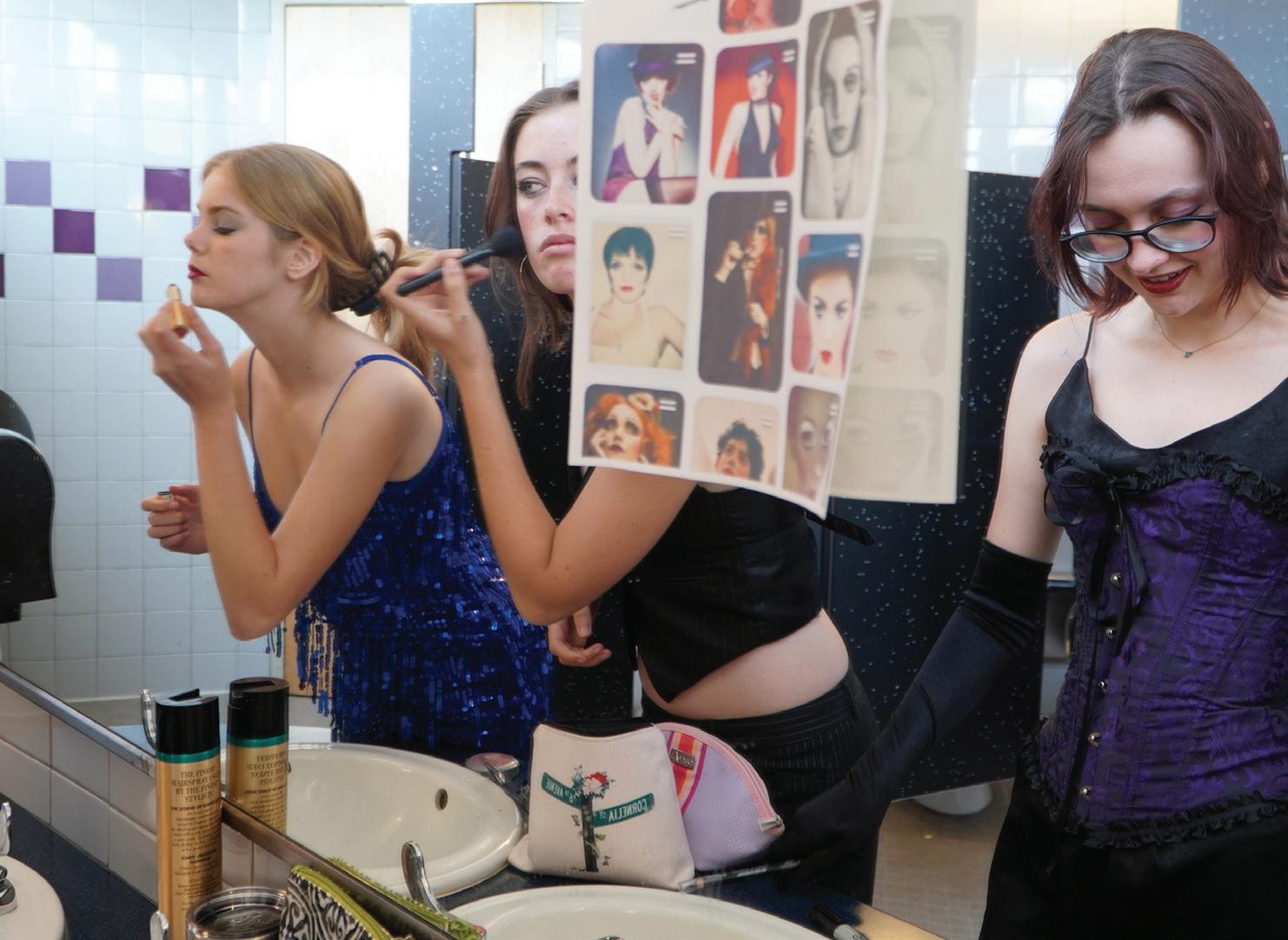
Senior Riki Fontes plays Fraulein Schneider, an older German woman who runs a boarding house in the show. For Fontes, the glamour made her gravitate to this production.
“‘Cabaret,’ [the musical], is so eyecatching: lights, action, dance, Kit Kats, singing! I was really intrigued by that,” Fontes said.
Set in the early 1900s in Berlin, the musical is inspired by John Van Druten’s 1951 play, “I Am a Camera,” which was adapted from the 1939 novel “Goodbye to Berlin.” The characters’ relationships center around the “Kit Kat Club,’’ a frivolous Berlin night club, representing the outside influences of global, political, social and economic conflicts. The plot revolves primarily around an American writer, Clifford (Cliff) Bradshaw, and his connection to an English cabaret performer, Sally Bowles. It also features Herr Schultz, the boyfriend of Fraulein Schneider, as the older couple comes to terms with new German nationalism in different ways.
Freshman Ty Hauser, who is a part of the Kit Kat Club and plays Victor, a cabaret boy dancer, detailed the process of
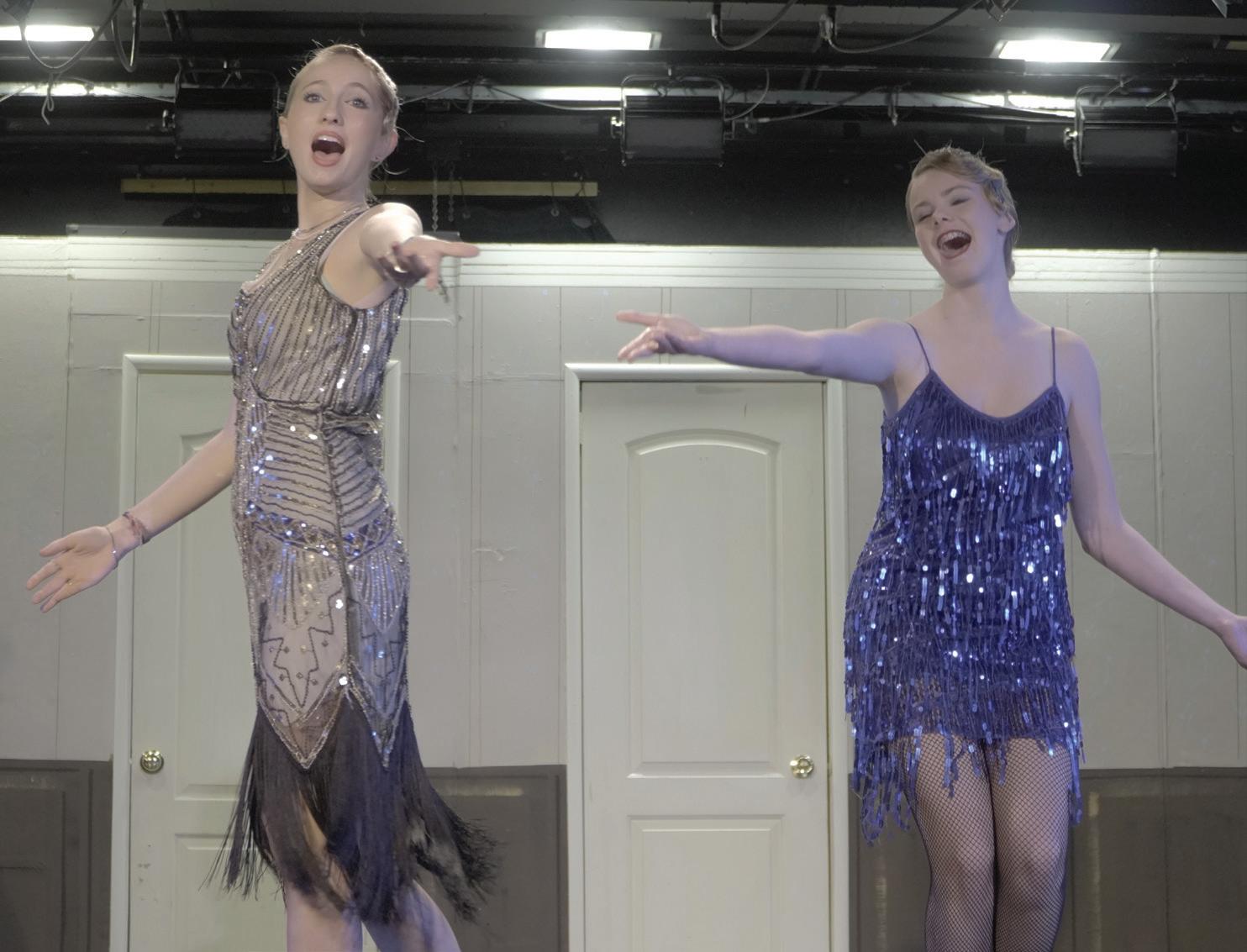
developing the show.
“The people playing the characters have such unique personalities and everyone is really invested in playing their characters to the fullest,” Hauser said.
All of this hard work and production collaboration, including lighting, props, sets, singing, dancing, acting and costumes, are displayed throughout the shows that run from Oct. 25 through 29 at 7 p.m., with a matinee at 2 p.m. on Oct. 29.
Although set in the first half of the 1900s, director and drama teacher Elena Wright believes that “Cabaret” is current
and relatable.
“[‘Cabaret’ is] such a relevant musical for today. It is super fun for kids and it is a place where they get to do material that is more adult,” Wright said. “Each of the character tracks has its own lesson. There are Sally and Cliff, the young lovers [who go] through their own journey, and what unravels them is very different than what unravels the older couple [in the show].”
Considering the mature themes within the musical, the actors researched historical context with a tactic called DramaTurgy — which is often used in
professional productions — enabling the actors to further understand the escapism and extreme nationalism so deeply embedded in the “Cabaret” characters’ lives. This research culminated in a series of presentations that the actors presented to their castmates.

Senior Gracie O’Connell, playing the Emcee, explained the importance of paying close attention to the show so as to not misunderstand any element.
“Something Redwood does really well is breaking boundaries of not only what people think high school theater should be, but also how people perceive what can be done in theater,” O’Connell said. “A high school production of ‘Cabaret’ is, in itself, breaking a boundary, in the sense that [on the] surface, it is a sexualized show, but there are a lot of difficult messages [within it too].”

Junior Calla Hollingsworth, playing Sally, has found her character to be not only fascinating, but engaging as well.
“There are so many layers to Sally,” Hollingsworth said. “She keeps me on my toes because she is such a complex and insane character [so] there is a lot to explore [in her story].”
Hollingsworth expects the audience to enjoy the show for its unique production and thrill.
“The adrenaline rush you get on opening night is incomparable to anything else,” Hollingsworth said. “It is a really good show, it is exciting and we have a lot of fun on stage. People will be able to see that energy throughout.”
tallan@redwoodbark.org
bark Page 4 • News October 28, 2022
TAKING INSPIRATION FROM historical trends, actors do their hair and makeup backstage to bring 1930s Berlin alive in the production.
Photo by Taylor Allan
BOTH STARRING AS Sally Bowles, Phoebe Putney and Calla Hollingsworth sing out the lyrics, “life is a cabaret.”
Photo by Taylor Allan
REHEARSING THE SHOW before opening night, “Cabaret” cast members Alexander Berkowitz and Sam Hjelmstad practice their musical scenes.
Photo by Taylor Allan
opinion opinion
Little green lies: Greenwashing is not sustainable
Article and Illustration by Charlotte Fishburne

Browsing the supermarket, consumers are blinded by sustainability buzzwords from products claiming to be “carbon neutral,” “eco-friendly” and “biodegradable.” These labels are quick to overwhelm, as it turns what should be a simple shopping choice into an ethical dilemma of how far customers should go to do their part for the planet. It appears to be a consumer’s responsibility to fix climate change and the world’s overconsumption through the products they buy.
Major corporations are contributors to guilting buyers by using sustainability as a marketing ploy to make more profits and gain more customers, otherwise known as corporate greenwashing. Corporate greenwashing is an obstacle to the environmentalist movement because it leads to a lack of trust between consumers and companies, whilst having trivial positive impacts on the environment.
Greenwashing refers to when a company uses green advertising to distract consumers into thinking they are more environmentally friendly than they are. According to Greenpeace, a London organization educating the public about the climate, tactics of greenwashing include token gestures, green buzzwords or images, making broad claims without evidence and weak attempts at carbon offsetting. Any greenwashed product is often thoughtfully curated by a marketing expert, who understands how to draw in customers.
Younger generations are even more vulnerable to greenwashing, as there is an immense amount of pressure on them to fix the problems they’ve inherited, including climate change and pollution. According to a report by First Insight, a company that analyzes customer experience and data trends, “73 percent of Generation Z consumers surveyed were willing to pay more for sustainable products, more than every other generation.”
Many companies have been called out by the public for greenwashing, for instance Windex in 2019. In order to make more sales, Windex advertised a specific bottle

they were selling as being made of “100% ocean plastic.” While this may seem like Windex helped clean up the ocean, the plastic was actually sourced on land. After the accusation, they changed their ads to promote using “ocean-bound plastic.”
While Windex’s initial claim was somewhat logical, the deceitful nature of the campaign left many customers feeling cheated.
In order to study the accuracy of sustainability marketing, the European Commission analyzed green online claims from businesses in fashion, cosmetics and household equipment industries. They found that “in 42 percent of cases, the claims were exaggerated, false or deceptive and could potentially qualify as unfair commercial practices under [European Union] rules.” Many of these claims made it impossible for customers to follow up on authenticity through a lack of information.
While many companies participate in this dishonesty, other companies have been rightfully transparent about their efforts, including Patagonia.
Owner Yvon Chouinard’s recent donation of the $3 billion company to climate change efforts models the exact kind of work companies need to do in order to maintain a truthful relationship with their customers.
Another company, August, which creates fully biodegradable cotton tampons and pads, uses the same vocabulary as other brands but goes further by including
Culture doesn’t equate to politics
By Ava Razavi
My ethnicity was once a heavy chain around my neck; something I carried around with a sense of dread. I’ll concede
destruction of my country. But as a young woman, my heart breaks for my fellow women who aren’t given the freedom to live as they please. Women who don’t get
detailed processes of how their products are scientifically produced and shipped. As stated on their website, “we are committed to being fully transparent when it comes to the manufacturing, distribution and sustainability of our products because greenwashing is NOT it.” With companies being open about what goes on behind the scenes, relationships with customers can be improved.
On the other hand, these marketing tactics of big corporations are unethical and are a result of society’s desire to have a clean conscience about the environment. Buying products that seem more eco-friendly can make consumers feel better about themselves. The majority of climate issues stem from big corporations; contrastingly, there isn’t a lot for normal people to do besides living a life they feel is “green” enough, which is why many people resort to buying “sustainable” products.
There is nothing wrong with a desire to be environmentally conscious, but it becomes problematic when this feeling turns into an obligation to buy more. In the end, the best step to take is simply accepting that the products we buy don't always make a difference. We can support organizations like Patagonia and August that have taken initiative to reinforce truly sustainable practices. Ultimately, the greatest changes come from the industry and not the consumers themselves. A lasting solution will involve stronger regulation, not only to curb greenwashing, but to force more sustainable practices in the first place.
cfishburne@redwoodbark.org
widespread government corruption and no freedom of speech, religion or assembly. These factors have impacts all across the globe which the average American sees
to be a gross misunderstanding between Americans and mass media regarding who is in support of the regime (hint: generally not the oppressed women who are harassed
Page 5
arazavi@redwoodbark.org Illustration by Carsen Goltz
Leaping over language barriers in Leadership
By Julia Frankus
Over the past few years, Redwood’s curriculum has shifted toward concentrating on racial disparities in the community through anti-racism seminars, guest speakers, various race trainings and more. According to an Oct. 2022 Bark survey, over 69 percent of Redwood’s student body identifies as white, students, teachers and administration have made it a priority to introduce initiatives that address racism — both microaggressions and blatant racism — at school. While these efforts are vital in making Redwood a safe and welcoming place for all students of color, there is often a forgotten group at our school that can encompass many socio-economic factors. Redwood’s student-run leadership organizations, including Link Crew, Leadership, Peer Resource, Bark and more, lack socio-economic diversity. More specifically, students from lower-income households or students who do not fluently speak English, are underrepresented.
Although recruiting students enrolled in Redwood’s English Language Development (ELD) program to leadership organizations may be easier said than done, the student body must find a way to give every student a voice. People often use the language barrier as an excuse to explain the reason that students are not featured in our leadership programs. Despite this, there are many steps that can be taken to directly address these obstacles that inhibit students from feeling welcomed and empowered to join leadership programs.
A simple solution to this issue is assigning bilingual students to the various leadership entities to translate. This will not only bind a bridge between English learners and English-speaking students, but also promote various points of view. In addition, programs like Leadership and Peer Resource can have dedicated bilingual students.
More specifically, a bilingual Spanish and Englishspeaking student could be accepted into these programs to account for the language barrier between English-speaking students and Spanish-speaking students. This student could help facilitate communication and emphasize the voice of minority groups at Redwood. The perspective of these students, or any minority, is vital to our community, as they are often some of the most underserved and underrepresented students.
Misconceptions regarding ELD students, often pertaining to intelligence due to a lack of English fluency, only worsen their struggles. According to an article by the Washington Post, “Because [ELD students often] speak little English, they [can be] misclassified as disabled and
placed in special-education classes. Some deserving, English as a Second Language (ESL) students are denied enrollment in programs for gifted students.”
Encouraging the inclusion of English-learning students in our leadership programs would open up a variety of opportunities — making decisions for our student body, giving feedback on our student press and much more. In addition, incorporating these students will likely help debunk many beliefs among Englishspeaking students and faculty.
Moreover, it is important to recognize that Redwood’s leadership programs consist primarily of the same students across the board. While there are many leadership opportunities at school, only a handful of students are truly involved. One could argue that this is by choice or random selection by teachers. However, Redwood has a student population of nearly 2,000: The chances that not even one student in each demographic represented at Redwood wants to participate in any form of leadership seems fairly unlikely.
This is not to say that the disparities across the leadership classes are the fault of any individual, but rather a failure in communication. While many leadership organizations act independently, recognizing which students are involved in various programs may help incorporate more students overall. For example, Peer Resource may not consider who is involved in other programs such as Bark or Leadership during the admissions process. Many of Redwoods’ programs are highly selective, only accepting the “most involved” or “academically achieving” students. While this may seem to make sense at first, it polarizes our school. Ensuring that all students have an equal opportunity to contribute to leadership at Redwood should fall into the hands of the administration. They can serve as mediators to ensure that programs like Peer Resource, Link Crew, Leadership, Bark and even Homecoming Court include not only a diverse group of students — in race, gender, various native languages and more — but also more students across the board.

Obviously, neither Redwood’s student body nor
Illustration by Calla McBride
economic status. Instead, Redwood should take a step to advocate for the overall inclusivity of everyone. This can ensure that all students not only feel comfortable joining any leadership program but are also inspired and welcome to do so. Uncomfortably approaching students to be assumed English-learner or lower-income and asking them to join is not a solution; however, pitching leadership to ELD classes may encourage students and help them feel supported and appreciated.
If Redwood wishes to label itself as an all-inclusive school, we must first ensure that our leadership is diverse in all aspects. Even setting aside socio-economic factors, leadership programs cannot portray a true depiction of our school if they disproportionately consist of the same groups of students. We must find a way to include all students, specifically those of lower socioeconomic statuses or in primarily non-English speaking households, to ensure that Redwood is truly a home to students where all voices are heard.
 jfrankus@redwoodbark.org
jfrankus@redwoodbark.org
bark Page 6 • Opinion October 28, 2022
cmcbride@redwoodbark.org
Redwood High School 395 Doherty Drive
Larkspur, CA 94939 www.redwoodbark.org
Editors in-ChiEf
Chloe Bishop Kelly Chuang
Sam Kimball
Shyla Lensing
hEad Copy Editors
Stella Bennett Ella Kharrazi
Copy Editors
Alex Coe
Ella Erwig
Gemma Favaloro
Justine Fisch
Mia Ginsburg Jordan Kimball
Sabrina Kizer
Sofia Ruliffson
Anna Royal Maya Winger
nEws Editors
Matthew Marotto
Aanika Sawhney
“The Bark, a student-run publication, aims to inform, explain, encourage and entertain the student body, while pledging to minimize harm, according to our handbook.”
Breaking news can break communities
Last week, a certain video may have ended up on your phone. Maybe it was forwarded to your family group chat, maybe it was on your Instagram feed or maybe it was Airdropped to you during second period. Upon seeing this video, you may have impulsively reposted it. Maybe you even laughed at it. Hopefully, you turned to trustworthy sources in hopes of clarifying information in this chaotic time. In doing so, you may have found that the Bark was silent — silent until now.
On Thursday, Oct. 20, a student and teacher were involved in a physical altercation with one another. As many in the Redwood community did, the Bark staff felt an array of emotions, such as shock, fear, curiosity and sadness. The Bark, a student-run publication, aims to inform, explain, encourage and entertain the student body, while pledging to minimize harm, according to our handbook. So when our missions of informing and explaining potentially contradicted that pledge, the Editors-in-Chief made an executive decision for the staff to take a step back and reflect.
We acknowledge that local news outlets released articles promptly after the event. While they did this, we were conflicted between publishing a piece in efforts to be a source of truth, as dangerous rumors were circulating, and being wary of adding fuel to fire. But looking back, we now believe it would have done the community a disservice to repost an already spreading video or risk using biased language, as we feel those aforementioned outlets have. We needed time to process and thoroughly understand the nuances and perspectives behind the altercation, as we feel the community should have too, and today, we stand by our decision to hold off on reporting.
social media and our classrooms within minutes, students had formed their own version of the event by the time the lunch bell rang.
Sensationalism, the spread of jarring stories to provoke public interest at the expense of accuracy, plagued Redwood in spoken form until Principal Payne’s email was sent out, but remains on the internet forever. Videos and photos of the altercation and what happened prior to it are useful for the purpose of private investigation, not public speculation. What’s more, creating memes and edits out of an altercation that will follow those involved for a lifetime is more than inappropriate. It’s heartless and inconsiderate to the mental and/or emotional conditions that precede such an event. Even liking or commenting on a post circulating this content promotes a culture of insensitivity and remains a part of one’s digital footprint for life. In a time where social media can spread a story faster than any truth-seeking publication can, it is imperative that the community is empathetic and intentional about what information or content they share.
With this in mind, the Bark is by no means shutting down the idea of reporting on what happened that Thursday. The conversation is still open. If we do cover it, it will be after we collect the necessary perspectives and developed information needed to do this complicated event justice. If we don’t, it will mean we have weighed the ethics of the situation and decided to abstain.
Respectfully, the Bark
POLICY: All editorials are unsigned and have been approved by the majority of the Bark staff.
In that fight or flight moment, it was apparent Redwood was just as conflicted as we were. As videos, comments and conversations flooded
A BARK to voting on the midterms this November; if only we could vote away our midterms.
A BITE to Prince Andrew getting the Queen’s corgis; someone misunderstood what “send them to the groomer” meant.
A BARK to Halloween candy; it’s so eerie-sistible we’ll be goblin it all night.
A BITE to College Board raising the price of AP tests. Looks like they’re only looking to make AProfit.
Have an opinion regarding anything that appears in the Bark or in general? We encourage our readers to submit letters to the editor. Letters to the Bark should be 500 words or fewer, typed if possible and signed. They may also be emailed to bark@redwoodbark.org.
A BARK to Becky in the College and Career Center. It’s not a “common” occurrence to find such support from someone when it comes to college.
A BITE to the freshmen not cheering for their own class skit. You’re not “under cover” in the stands.
A BARK to students making their early college deadlines. Con-draculations to finishing October.
A BITE to the bug going around after the
Homecoming dance. Seems like the long lines weren’t the only thing buggin!
nEws Editor on-Call
Lily Reese
opinion Editors Erica Block Julia Frankus
fEaturE Editors
Ava Razavi Dani Steinberg
sports Editors
Coco Boyden Ingrid Houtkooper sports Editor on-Call Arjun Aujla
rEviEw Editors Kate DeForrest Claire Silva
lifEstylEs Editors Rori Anderson Emily Block
spanish Editor Gillian Reynolds
podCast Editor Caitlin Beard
vidEo Editor Will Parsons
BusinEss ManagErs Cole Seifer Wyatt Turkington
MultiMEdia ManagEr Sarah Goody
survEy ManagEr Ani Svendsen
art Consultants Carsen Goltz Calla McBride
soCial MEdia ManagErs Sophia Buckholtz Cameryn Smith
wEB dEvElopEr Aidan Carney-Skytt
rEportErs Sawyer Barta Elsa Block Ben Choucroun Emilie Erickson Grace Gehrman
Charlotte Fishburne Pasha Fooman Lili Hakimi Hannah Herbst Sydney Johnson Andie Johnston Gil Ladetzky Robert Lapic Lauren Poulin Bowen Rivera
BARKS and BITES are the collective opinions of the BARK staff concerning relevant issues. BARKS are in praise of accomplishments, while BITES criticize decisions or events.


Gabriella Rouas Michael Seton Maddie Sofnas Sam Sumski Bella Wagner Kyler Wang
Mayson Weingart Natalie Welch
advisEr
Erin Schneider
editorial
bark
barkwww.redwoodbark.org Page 7 • Opinion
Safe Injection Sites
A necessary Step In Society
By Stella Bennett
“I have long supported the cutting edge of harm reduction strategies,” Governor Gavin Newsom wrote in a veto letter. “However, I am acutely concerned about the operations of safe injection sites without strong, engaged local leadership and well-documented, vetted and
Francisco in size and age demographic. For instance, from 1991 to 2008, a supervised injection site in Barcelona, Spain was credited with a 50 percent reduction in OD mortality. Furthermore, in Vancouver, Canada, in the area surrounding an injection site, there was a 26 percent net reduction in OD deaths compared to the rest of the city. With these examples in mind, it is evident that supervised
infections. Trained medical professionals supervise these facilities, allowing them to properly identify, diagnose and treat patient cases beyond solely HIV related illnesses. Additionally, these professionals can provide users with information to seek help and support on their path to sobriety.
Growing up in a state where marijuana is legal, while other drugs are often used illegally, I am constantly exposed to substance usage. With drugs targeting a younger audience and aiming to influence high schoolers, it is crucial that we work to decrease exposure. Supervised injection sites do just this: they take drug usage off the street and move it to private facilities where the public cannot be motivated. According to an October Bark survey, 66 percent of students have either used drugs in public or seen drug usage in public areas. If people are going to continue to use drugs, it’s necessary that we make it less publicized to younger audiences.
Some argue that supervised injection sites are not the solution, and instead, they exacerbate the issue by taking money out of taxpayers’ pockets. Supporters of this belief point to the fact that a supervised injection site had an annual cost of about $1,222,322, which can be a heavy burden on taxpayers. However, they neglect to show the profit that these sites obtain. For every dollar spent on these operational costs, the injection site generates $4.22 by reducing the amount of hospital care users would seek without these facilities. Additionally, an article by American Family Physician proposed a hypothetical site in Baltimore, Maryland, and concluded that it would create $7.8 million in savings annually. These sites can produce a profit that can support other issues in the U.S., such as poverty and healthcare.


Although there are arguments against injection sites, illegalizing most drugs has only pushed the activities underground while maintaining high usage rates. If we can’t stop people from taking drugs, then at least we must make sure that they are not dying from overdoses or influencing a younger audience.
“Coming to a safe injection site, [users] find a place that has kind people who are willing to assist with things that reduce the suffering of untreated substance use disorders,” Dr. Christopher Johnston, the chief medical officer at Pinnacle Treatment Centers, said. “It appears to motivate people to take incremental steps toward better health, and sometimes toward participating in conventional substance use disorder treatment.”
sbennett@redwoodbark.org
“That” girl succeeds in setting unrealistic expectations
By Grace Gehrman
From the typical 5:30 a.m. wake-up time, copious amounts of green smoothies, expensive work-out sets and the bizarre emphasis on journaling, “that” girl has dominated social media sites such as Instagram and Tiktok. This trendy female ideal presented by these platforms sets unrealistic standards for beauty, success and fulfillment.
“That” girl is a popular archetype of a female who wakes up early, works out, journals, meditates, recites affirmations and does an assortment of other “wellness” rituals. While there is nothing inherently bad about promoting these healthy habits, the standards they set are unattainable in a plethora of ways. This trend is marketed as being achievable, while
realistic because of time or financial constraints, among other reasons.
Júlia Ávila, a publicist who represents influencers, described the unrealistic standards that “that” girl presents.
“This ideal has become romanticized. It’s something you can aspire to but it’s practically impossible. Some people with a certain work timetable may be able to [maintain this lifestyle], but for everyone else it can be toxic and overwhelming to see people you admire [preaching] this sort of thing,” Ávila said in an interview with the newspaper El País.
Furthermore, sophomore and TikTok user Kaitlyn Widman explained the challenges of the “that” girl lifestyle. She highlighted the struggle for high school students to prioritize this way of life when they’re also balancing things like sports and extracurriculars.
“If you do sports, that's at

be like that.”
Widman also touched on the exclusivity
study conducted by Pew Research Center, 15 percent of teenagers think social media alters reality and gives teenagers an unrealistic view of other people’s lives.
While fitting in is a natural goal of many teenagers, social media exacerbates this by showing onesided narratives that promote lifestyles and ideals that don’t work for everyone.
Widman elaborated on this, commenting on her own perspective as a teenager on social media. She points out the toxicity in the one-size fits all approach to beauty and fulfillment.
“People on social media assume that one thing is this golden standard; what you have to be if you want to be accepted,” Widman stated.
extracurriculars or sports], people have jobs,” Widman said. “I think it's really only realistic for some people [to] achieve that. Things happen and [your life] can’t always
as “that” girl, on social media as a reality. The “that” girl ideal is just the latest fabrication of real life that is trending. According to a
“[Beauty, success and fulfillment] look different on every single person; and if you portray it as one thing you're going to have no diversity in how people present themselves.”
ggehrman@redwoodbark.org
bark Page 8 • Opinion October 28, 2022
Illustartion by Carson Goltz
Illustrations by Calla McBride
español español
Collectively, the Bark took the last cycle to meet with teachers of the Spanish department to work together and find the best way to integrate Spanish writers’ work into the Bark. We have formally made the decision to hand off the Spanish section to Spanish classes. Spanish students or any member of the Spanish-speaking community at Redwood are welcome to write and submit stories to the Bark. Editor Gillian Reynolds will continue her role in laying out the section and working with this community. Please reach out to her if you have any interest in writing for the Spanish section by email: greynolds@redwoodbark.org
For this cycle, Profe Alsina’s Spanish for Spanish Speakers 3-4 honors class responded to the question: Who is a person of Hispanic descent who is an inspiration to you?
Colectivamente, el Bark tomó el último ciclo para reunirse con profesores del departamento de Español, para trabajar en conjunto y encontrar la mejor forma de integrar el trabajo de los escritores de habla española en el Bark. Formalmente, hemos decidido dar nuestra columna de la sección de Español a los estudiantes de clases de Español. Los estudiantes o miembros de la comunidad de hispano hablantes, pueden escribir y enviar sus artículos al Bark. La editora Gillian Reynolds, continuará su papel editorial, y trabajará con los miembros de la comunidad hispano hablantes. Si estás interesado en participar, por favor envíale un email a: gillian.reynolds@student.tamdistrict.org
Frank Rubio
Por Mayra Campos
Frank Rubio nació el 11 de diciembre de 1975 en Los Ángeles, CA, en una familia de padres salvadoreños. Frank Rubio fue a El Salvador con su madre por 6 años, donde aprendió a leer y escribir perfectamente el español. Más tarde la familia se mudo a Miami, Florida, donde asistió a la escuela secundaria. En la universidad estudió medicina, y después de graduarse fue a la academia militar y obtuvo una licenciatura en relaciones internacionales. Allí se convirtió en piloto y líder de pelotón en la brigada de aviación de combate y comandante. Rubio está casado, su esposa se llama Deborah y tienen cuatro hijos.
En 2017, Rubio fue seleccionado como miembro del grupo de astronautas de la NASA y comenzó un entrenamiento de dos años. Él viajó al espacio como astronauta el 21 de septiembre de este año, en una misión que duró 6 meses. En esta misión espacial los astronautas darán paseos e investigarán la microgravedad y cómo esta afecta al cuerpo humano.


Frank Rubio es reconocido en EE.UU a El Salvador y en muchos otros países, porque levanta la bandera salvadoreña, y da el ejemplo de que todo es posible y que hay talento en la comunidad latina. Algunos premios que Frank Rubio ha recibido son la Estrella de Bronce, la Medalla de Servicio Meritorio, la Medalla de Economía del Ejército y la Medalla de Logro del Ejército.
Guillermo Del Toro

 Por Andre García
Por Andre García
Guillermo del Toro es uno de los cineastas más populares y creativos de la década, un director aclamado por sus películas. Nació el 9 de Octubre de 1964 en la ciudad de Guadalajara, Jalisco en México. Creció junto a sus padres Federico del Toro y Guadalupe Gómez y su hermana pequeña Susana del Toro. Fueron criados de forma estricta por sus padres pero de vez en cuando cometían travesuras. Guillermo del Toro a los ocho años empezó a jugar
con una cámara Super 8 de su padre y comenzó a crear cortometrajes.
“Mi padre poseía una pequeña cámara, muy compacta, que funcionaba sólo a 24 imágenes por segundo. Nada de “stop motion” o de alta velocidad. Muy simple... Se la tomé prestada sin que él lo supiera, por supuesto” dice el famoso director.
De niño Guillermo del Toro temía a los monstruos que lo atormentaban. Hasta que en una noche hizo un pacto con ellos, si lo dejaban ir al baño, él se volvería su amigo, y el pacto se había firmado. Asi, se
Para este ciclo la clase de Español de la Profe Alsina, para hablantes de español 3 ⁄ 4 honores, respondieron a la pregunta, ¿Quien es la persona de descendencia hispana que es tu inspiración?
Página 9
FRANK RUBIO SE para junto a Anne McClain frente a la bandera.
Imagen cortesía de Northwest Military
Alexandria Ocasio-Cortez
 Por Pía Kaltreider y Mía Johnson
Por Pía Kaltreider y Mía Johnson
Alexandria Ocasio-Cortez, también conocida por su iniciales AOC, es una política en la cámara de representantes del distrito 14 de Nueva York desde 2019.
Solo tiene 32 años y es la mujer más joven en ser elegida en el congreso. AOC nació en el sur del Bronx de Nueva York pero sus padres son de Puerto Rico. Cuando
a la universidad de Boston y antes de ser política fue camarera para ayudar a su madre. Era una apasionada activista y quería cambiar cosas que no le gustaban en el mundo.
Alexandria Ocasio-Cortez es demócrata y cree en el seguro médico del estado, la escuela pública gratis, el Green New Deal y sacar US immigracion y aplicación de aduanas.

¿Qué es el Green New Deal? Es una
el 2050 a través de impuestos sobre el carbono. También quiere crear 240,000 trabajos nuevos cada año. Bernie Sanders y un grupo de personas en el Congreso, como AOC, Ilhan Omar, Ayanna Pressley, Rashida Tlaib, Cori Bush, y Jamaal Bowman, apoyan esta legislación que costaría 16 billones de dólares para implementar. El Green New Deal tiene el apoyo de personas que son más liberales y demócratas.
¿Cómo es posible que AOC fue de camarera a trabajar en la Casa de Representantes? ¿Cómo fue a la Met Gala (vistiendo en un vestido muy controversial que decía “tax the rich”) cuando solo unos años antes estaba trabajando en una taquería? Es simple: siempre fue activista. wSiempre trabajó duro y sabía cómo tratar a la gente. Sabía lo que la gente necesitaba ya que sabía cómo era vivir en un sitio duro. En una situación, Trump dijo al grupo con AOC que deberían volver y arreglar los países de donde vinieron en vez de insultar al gobierno de los Estados Unidos, un comentario muy inapropiado. A lo que AOC respondió con:
“No dejamos las cosas que queremos, y cuando queremos a este país, proponemos las soluciones para arreglarlo.”
Y agregó que estos dichos son algo que alguien muy racista dice, no el Presidente de los Estados Unidos.
Antes de trabajar en el gobierno Alexandria Ocasio-Cortez trabajaba para el instituto hispano national, un grupo
que trabaja para ayudar a latinos, particularmente a los más jóvenes. En la elección primaria Alexandria OcasioCortez ganó contra Joe Crowley con un 57.13 por ciento. Joe Crowley es un político demócrata y se esperaba que ganara. Luego ganó contra un republicano Anthony Pappas en la elección general. Ganó con la mayoría del 78 por ciento, con casi 100,000 votos más que el. Tenía el apoyo de Barack Obama, presidente número 44 de los Estados Unidos, y Bernie Sanders, el senador de Vermont. Ahora va a ir contra la republicana Tina Forte en la elección general.
Alexandria Ocasio-Cortez honra su herencia hispana de muchas maneras, pero un ejemplo es desde el principio del mes de la herencia hispana de este año. Escribió en Twitter: “Este Mes de la Herencia Hispana recordamos que la nuestra es una herencia de resiliencia. Los tiempos son difíciles: desde la pandemia de COVID-19 hasta las políticas de inmigración despiadadas, nuestra comunidad enfrenta grandes desafíos. Pero hemos superado la adversidad antes y lo haremos nuevamente.” Alexandria OcasioCortez es una persona importante en nuestro mundo quien honra su herencia hispana y hace buenas acciones para la comunidad.
Selena Quintanilla
Por Samantha Tecum, Emily García y Diana Coronado
Selena Quintanilla fue una cantante muy famosa que inspiró a muchos y cambió la industria de la música. Nació el 16 de abril en Lake Jackson, Texas, y murió el 31 de marzo de 1995 a la edad de 23 años. Empezando en su niñez, Selena cantó en una banda familiar de nombre “Selena y Los Dinos” con sus dos hermanos Suzette y A.B en el restaurante que tenían. Sus padres Abraham y Marcela Quintanilla les apoyaron. Abraham tuvo la idea de empezar la banda en primer lugar. Al comenzar la banda y obtener popularidad mucha gente pudo ver el talento de Selena. Con el paso del tiempo muchas personas comenzaron a darle trabajo en otros lugares y eso la ayudó en el camino a la fama.


En 1983 salió su primera canción “Se acabó aquel amor” la cual grabó con tan solo 12 años. En 1992 lanzó su primer hit “Como la flor” y fue una de sus canciones más famosas. Otras canciones populares son “Amor Prohibido”, “Baila Esta Cumbia”, “Bidi Bidi Bom Bom” y “Dreaming of You’’. Muchas de estas fueron escritas por su papá y su hermano. Sus canciones ganaron popularidad muy rápido y fueron transmitidas en la radio para que todos las pudieran escuchar. Una de las primeras fue “Como la Flor.” Para ella fue más fácil ser famosa porque ya estaba dentro de los Estados Unidos y vendió 18 millones de
discos en todo el mundo.
Selena ganó muchos premios por sus canciones y su talento. Ganó dos Grammys, uno por su álbum “Selena Live” para “Best Mexican American album” en 1994 y uno después de su muerte para “Lifetime Achievement Award” en 2021. Ha sido nominada a 86 premios en total y ha ganado 67; ganando 36 premios de música tejana, 14 premios billboard latinos de música, 10 los nuestro premios, 5 BMI premios y un premio de la sociedad de América de compositores. Junto con eso Selena está en el paseo de la fama de la música latina desde 1995, también ha ganado premios para vocalista femenina tejana del año y animadora femenina desde el año 1987 hasta 1996. También en 1996 ganó canción del año para “Amor Prohibido”. Por estos premios Selena obtuvo el título de la Reina de Tejano.
A los veinte años Selena Quintanilla se casó con un hombre de nombre Chris Perez (22 años en ese momento) en 1992. Se conocieron en 1989 cuando Chris se unió a la banda “Selena y los Dinos” como guitarrista. Selena también tenía un sueño de empezar su propia línea de ropa y por eso abrió su propia boutique llamada “Selena Etc” el 14 de enero 1994. Ella tenía muchows fans y sus tiendas eran una gran atracción para ellos. Más adelante Selena abrió otra boutique completando su sueño.
Yolanda Saldívar era una de sus mayores fans. En el año 1995 Selena y su padre descubrieron que Yolanda
despidieran y la reemplazaran como presidente del club de fans. El 31 de marzo Yolanda quería reunirse con Selena para darle los registros financieros. Por lo que se encontraron en un motel, donde Yolanda mató a Selena. Selena se desangró por sus heridas y murió a la edad de 23 años. Una gran inspiración que cambió la música para mejor, Selena fue un modelo a seguir para muchos.
bark Página 10 • Español October 28, 2022
LA FOTO DE Selena llega al Paseo de la Fama de Hollywood.
Imagen cortesía de Walmart
Imagen cortesía de reddit
AOC PRESENTE APASIONADAMENTE su caso respaldando al senador demócrata Ed Markey para la reelección en Massachusetts.
feature feature
‘Beyond the badge’

The shifting roles of law enforcement in Marin
 By Sam Kimball
By Sam Kimball
In 2020, the United States public safety force comprised of 696,644 fulltime law enforcement officers. According to the Federal Bureau of Investigation, this number only includes officers who regularly carry a firearm and an official badge, have full powers of arrest and
week as the most beneficial aspect of training and the best time to reflect on the skills learned during the police academy.
“We need to make sure that [the officers] are learning what techniques, policies and procedures [they need to follow] since that’s what [tells us what to do] on a daily basis. At the end of training, we have what’s called a ‘shadow week’ where
Taupier remembers her days at Tamalpais High School as an administrator observing the SRO involved in school activities, but acknowledges the changing conditions.
“[The SRO program] has seen an evolution. It has been paid for through a bond or parcel tax from the community, so it is funded through the police force and not the school district. Years ago [when I was the assistant principal at Tam], the officer was more integrated into the school, coming to events, but then we moved away from that. There is a lot of discussion about having a police presence on campus and what that does, but the officer is never used for discipline,” Taupier said.
The SRO, in addition to ensuring campus safety, assists with resources otherwise unavailable to the TUHSD.
“Another way [the SROs] are supportive to us is through threat assessments. Oftentimes people won’t know a threat assessment is happening, but [once it is reported], a threat assessment team is put together, and the school resource officer is often on that team,” Taupier said. “The [SRO] has the ability to do a wellness check [in case of a threat], which in this day and age is very helpful [and we don’t have access to that].”
police budgets and paint all police as the villains. It has resulted in more crime,” Dubin said. “I do think [police officers] need to be given more resources so they can have better community policing [practices] as a lot of what they do should not be criminal matters. There should be social workers and community services that are working alongside the police to deal with matters that are more appropriate.”
Bennett also points out the mass amounts of police violence that has swept the nation for decades, including an incident of police brutality sparking protests in September in San Rafael. In the past year alone, 1,039 people in the United States have been shot and killed by police. Bennett views this brutality as an ongoing problem, and one that needs to be understood.
“When you focus more on mental health issues and systemic oppression, you start to see the roots of what is considered criminal behavior. The outcome [of law enforcement training] is continued over policing of Black and Brown people,” Bennett said.
Training
According to a report by The Institute for Criminal Justice Training Reform, California law enforcement officers must complete 664 hours of basic training, exceeding the U.S. average of 652 hours. A total of 37 states, not including California, allow police to work and immerse themselves in the field before attending basic training. However, Central Marin Police Department Corporal Jeff Peterson reiterates this is an ever-changing system, and with more police activity comes more fluctuation in the requirement.
“Academy curriculum and state law has changed immensely since the events of the past couple years,” Peterson said. “Lethal force and what used to be ‘use when reasonable’ has become ‘use when necessary.’ We are trained better on de-escalation, and have attended crisis intervention training, recognizing mental health crises or other factors that may go
firearms training. Here I am, 24 years into my career and a sheriff, training. It is extremely important. Our role goes beyond the badge,” Scardina said.
The School Resource Officer
Since its start about two decades ago, the Tamalpais Union High School District’s (TUHSD) School Resource Officer Program has worked with neighboring police departments to assign an individual to serve as a public safety officer in their school district. Peterson served as the school resource officer (SRO) from 2019-2021 for many of the TUHSD schools, including Redwood. Peterson took on the role due to his interest in building connections with students and his educational experience as a teacher at Marin Country Day School and Town School for Boys. Since it originated, Peterson has noticed changes within the program, associating them with the constant societal shifts.
“[About two decades ago], the SRO had
With 113 incidents of gunfire on school grounds in the U.S. this year, Peterson notes that while spending time on campus, he would try to avoid the thought of a school shooting, but it would always appear in the back of his mind.
“Every morning I would pick the campus to [patrol], and it would be terrible to think that way, but if you pay attention enough, you know that these things do happen,” Peterson said. “[A school shooting] is something that I would think about when [students] arrived at school. I thought about it every morning and I would visualize what I would do with life [in general if that were to happen].”
The Allocation of Police Funds
According to Pew Research Center, 15 percent of adults now say police funding should be decreased, a decline from 25 percent in 2020. In Marin County, community members have formed organizations in support and against police presence and the terms “defund the police” and “fund the police.” Lisa Bennett, a trustee for the Sausalito-Marin City School District and founder of the nonprofit, Standing up for Racial Justice, does not associate safety with law enforcement.

“I have a view of the words ‘safety’ and ‘public safety’ as one that doesn’t involve policing,” Bennett said. “In an idyllic situation where people feel safe in their lives, have opportunities, access to education and support services, there is less of a need for policing to manage a
However, another community advocate Laurie Dubin is a parent of three Redwood graduates and founder of Be the Influence, a parent education and support program that addresses substance use.
Dubin appreciates the role the police play in her organization and sees opportunities to allocate more resources to police
“‘Defund the police’ is a horrible term. It’s very counterproductive and damaging to society. You slash
Taking the necessary steps to improve the functionality of Marin in her eyes, Bennett emphasizes the importance of taking action with true intent in mind.
“[Society] frowns on performative actions. You hang up a sign that says ‘Black Lives Matter’ and you think you are done. Unless you have committed to doing the work, to make yourself vulnerable, and to reconnect with your humanity, you are not going to be an effective changemaker in the community,” Bennett said.
Community Involvement
Every situation involving law enforcement requires collaboration, and without community trust, officers cannot do their jobs to the best of their ability. San Rafael Police Department Lieutenant Todd Berringer cites cross-collaboration as a crucial aspect of keeping the community safe. As a result, he always looks for ways to involve community partners in his work.
“[Law enforcement] knows that we can’t solve problems just by ourselves. Not only do we collaborate with [members of the area], but we are doing a lot of cross-collaboration with other departments. [The community] is vital,” Berringer said. “Our circle of safety requires trust and mutual cooperation, and if you have a breakdown of either of those components, you are not going to have a safe and vibrant community.”
Similar to Berringer, Scardina hopes to increase community involvement and truly values the input from his peers and those who see the world from a different perspective.
“Some of the best changes and decisions we have made as an organization in the last couple years have not come from me, they haven’t come from our undersheriff and they haven’t come from our captain, but they have come from our line staff and from our deputies who are on the street. The same thing [could be said] for our community. If our community would like us to do something different, we need to hear from them; what can we, the Marin County Sheriff’s Office and law enforcement do differently to better serve everybody?”
Page 11
skimball@redwoodbark.org
Education may The complexity of trauma
By Caitlin Beard
“Addressing a past trauma in class is not an ideal place to address it, or for it to come up,” District Wellness Director Jessica Colvin said. “When we’re talking about trauma, we often don’t know how our bodies are going to react. It can feel physically unsafe and even cause a panic attack.”
Sensitive materials, including discussions of race, gender, ethnicity, mental illness, religion, politics, sexuality and disability, are frequently presented in high school classrooms, especially in humanities courses. Exposure to sensitive content may cause students with trauma to experience severe physical and emotional reactions, such as agitation, anxiety, dissociation and panic attacks. This phenomenon is not rare, as 35 percent of students report consuming content in school that caused them emotional or physical distress, according to an October 2022 Bark survey. Trauma can be defined as the lasting, adverse effects on an individual after experiencing a deeply disturbing event.
Despite the dangerous reactions that some students may have when interacting with traumatic content, many educators continue to believe that the presentations of these educational materials are imperative.
Josh Chan, a Redwood alumnus and former president of the Mental Health Awareness Club, values high school teachers who are mindful of their lessons’ potential effects on students’ mental health.
“I have to commend the few teachers that give warnings … especially when you look at different readings throughout history you’re bound to come across really sensitive topics. I think it’s important for there to be communication between students and teachers when they [will be discussing] these topics, because you never know when someone in the room is actively going through [a difficult time],” Chan said.
As a current junior at the University of California, Santa Barbara, Chan appreciates how
his professors typically post a syllabus outlining the topics discussed in each class and providing students with ample notice to prepare for sensitive material or opt out for an alternative assignment.
Locally, San Andreas High School, one of five schools in the Tamalpais Union High School District (TUHSD), often creates assignments to accomodate students with trauma. Currently, 60 students are enrolled at San Andreas, many of whom struggled with a traditional learning style at the larger schools due to their trauma or anxiety. To support these students, San Andreas fosters a unique, trauma-informed school culture that refrains from cold-calling students or imposing anxiety-inducing assignments.
Dominique Uskert, the social studies teacher at San Andreas, recognizes many benefits to this modified style of learning, including the creation of a safe learning environment.

“You need to create a classroom where your students feel like they can be heard, be seen, share their ideas and where they’re not anxious. If I’m creating a hostile environment, [students] won’t want to come back the next day. They won’t be able to even get the point of my lesson,” Uskert said. “[Not only is it] damaging to my long-term relationship with [students], but it’s damaging to their learning that day.”
Uskert’s experience in teaching students with heightened levels of trauma has informed her of the best ways to teach in accordance with these sensitivities. To her, providing advance content warnings is the most effective path to building trust with students.
“Just last week I knew I was going to talk about something that would be personally challenging for one of my students to hear, so I let him know a day in advance and I said, ‘This is what I’m planning on covering. If you feel uncomfortable, I completely understand if you want to opt-out of class that day,’ instead of making a blanket statement like, ‘You can stand up and walk out of the room if this is hard for you,’ because that could be even harder to do,” Uskert said.
Along with early content warnings, in some
cases, she adjusts her lessons to ensure her students are receiving honest content in a sensitive manner.
“I want to be really mindful that a lot of our students have lived through fairly traumatic experiences and they don’t want to come to school and be traumatized even more,” Uskert said. “[Recently], I was creating an assignment [about] indigenous peoples and the role of women and how they are revered in certain tribes. … I was explaining things that had to do with male dominance and there was a reference to rape. When I was writing it out, I changed the language because [rape] is such a harsh word to hear. This is not to shy away from things, but to make sure that I’m presenting [the lesson] in such a way that is really mindful.”
Jessica Colvin Wellness direCtor
While Uskert acknowledges that Redwood’s significantly larger classroom sizes present challenges for teachers to give the same level of individual attention to each student’s background and needs, she suggests ways to mitigate damaging responses to sensitive material. For her, this includes taking note of students’ body language, facial expressions and how often they leave the classroom during potentially sensitive content. She then follows up with her students if she notices a pattern of discomfort.
San Andreas Math teacher and instructional coach Chris French participates in committees to discuss and amend teaching tactics and their alignment to the district’s equity mission as part of his position. French does not see the difference in class sizes between San Andreas and Redwood as an explanation for educators being less cautious.
“In terms of bigger classes, yes, there are 30 students in the class, but there’s a small percentage of those students that are having consistent issues with anxiety or things that are shutting them down. There are ways to find that information without seeming invasive or making the students feel ‘othered,’” French said.

Uskert finds an effective way to get to know students both at the beginning and throughout the year is by asking students, “I wish my teacher knew ___.” This allows her to identify areas of content or assignment types that may cause stronger emotional reactions in different students. While some Redwood teachers conduct surveys at the beginning of the year, regularly offering inquiry-based questionnaires can lead to progressively more authentic responses as trust builds between the student and the teacher.
French also recognizes the power of consistent surveys and check-ins in order to build trusting relationships with students.
“If all teachers are doing [regular surveys], then all teachers are developing a level of trust in their students [and giving off a message that] the teachers here get it. The teachers at Redwood are trying to look out for others. And it is a lot of work, but at the same time if students aren’t learning, then it’s the work that’s worth putting in [for teachers],” French said.
He advises that teachers familiarize themselves with the everyday struggles that increasing numbers of teens are facing. For example, trends in adolescent mental illness are spiking, and these mental health declines are expanding to become a public health issue, largely prominent in Generation Z. In a 2020 survey conducted by McKinsey & Company, a global management consulting firm, results showed that members of Generation Z were two to three times more likely than other generations to plan or attempt suicide.
i want to be mindful that a lot of students have lived through fairly traumatic experiences.
Dominique Uskert San AnDreaS TeAcher
if i’m creating hostile environment, [students] want to come the next day.
Illustrations by Calla McBride and Carsen Goltz
may bE aliEnation trauma in the classroom
Beard and Chloe Bishop
“We’ve been given so much information as educators and as a society about what teens struggle with,” French said. “What teens are going through is not what I went through. What teens are going through now is totally different and our job is to absorb all of that because our job is to support teens. We have to get inside their heads in a way that makes them feel supported, seen and understood, so they feel like they can trust us.”
tor
Redwood’s Wellness Center connects students with professionals who are knowledgeable about current trends in teens’ mental health. Catherine Stern, a Bay Area Community Resources (BACR) therapist who works in the Wellness Center, perceives extensive warnings in classrooms as unproductive to creating a safe learning environment.
“It’s important to be able to see something uncomfortable, hear something uncomfortable and manage it,” Stern said. “The more we avoid [trauma], the stronger it gets.”
Stern also acknowledges that schools are safe
students coming to terms with mental struggles, or assist them in their journey towards receiving help, other topics may warrant more caution.

“We often teach about self-harm really carefully because there are certain topics that you don’t want to be ‘contagious.’ … You don’t ever want to give someone ideas on how to start an eating disorder or how to start self-harming. … The aim is to keep people healthy and safe,” Colvin said.
said.
For those who want to process or step away from sensitive content shown in class, Redwood’s Wellness Center is available throughout the school day to provide support and counseling.
bark@redwoodbark.org
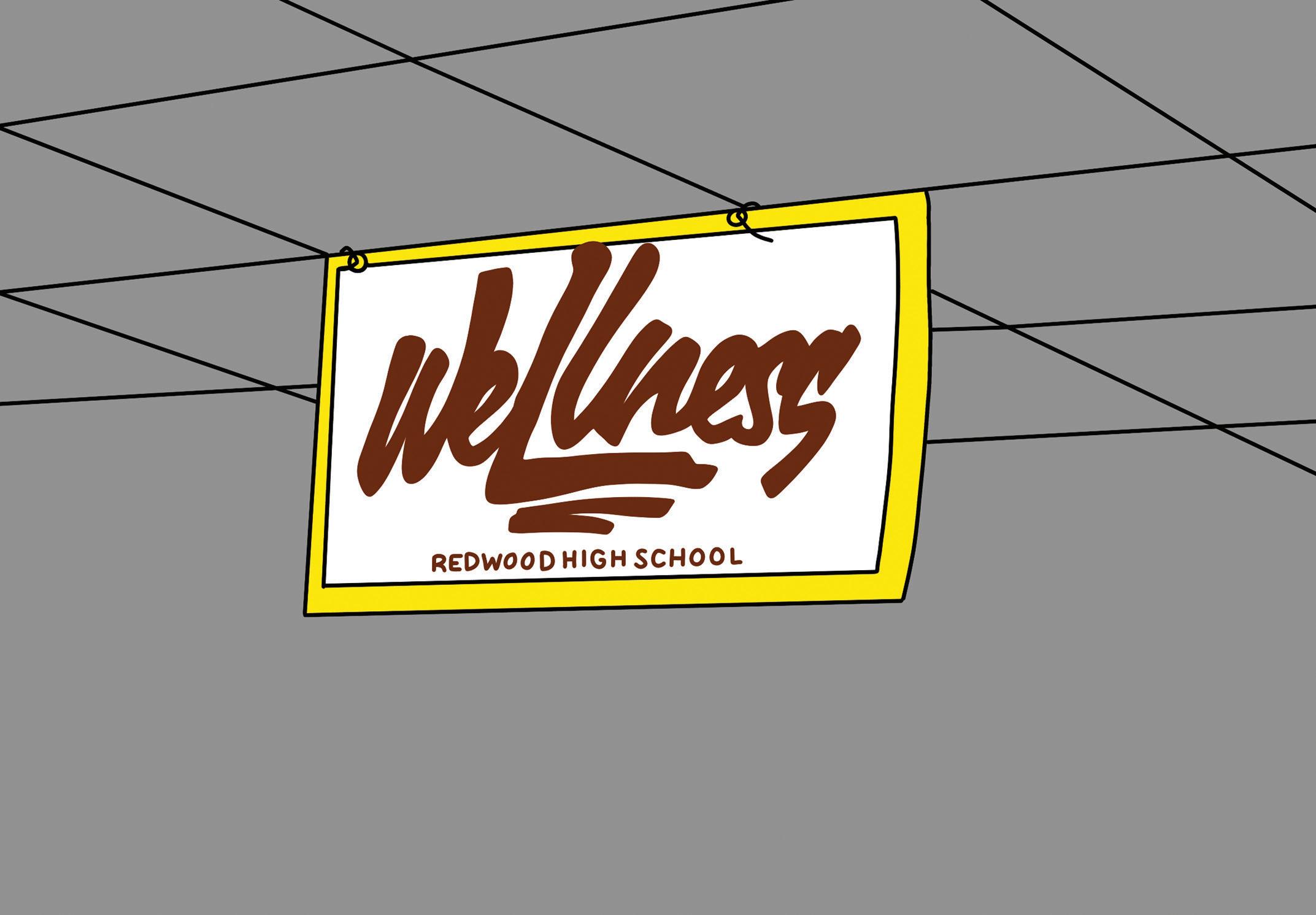
creating a environment, won’t come back day.
Then versus now
The ever changing college experience
By Anna Royal and Sofia Ruliffson

From admissions and application processes to academics and social lives, the experiences of college students have remained consistent in some ways, yet ever changing in other aspects. As application deadlines approach in the upcoming months, college has been prominent in many students’ everyday lives, especially in conversations with their parents. Over the past generations, colleges have greatly shifted in their application processes, their diversity and their student academic and social lifestyles.
The Application and Admission Process
With technological advancements and intensified competition, the admissions and application processes have evolved. The college application system has further changed due to the creation and evolution of the online Common Application (Common App), a portal used by hundreds of colleges to receive applications, including virtual aspects such as submitting video interviews or online portfolios for some schools.
College and Career Center specialist Becky Bjursten has worked at Redwood for four years and seen these changes firsthand.
“With using an application system like Common App, [students] have access to 900 colleges on one application. That changes the amount of schools students apply to and how many schools [students] can access information about,” Bjursten said.
Gael Casner, a private college counselor who previously worked as a University of California (UC) Berkeley Admissions Evaluator in 2006, 2007, 2010 and 2011, has seen other factors of applications change, including the formatting becoming more user friendly.
“There weren’t portable document formats [PDFs] 20 years ago, so a lot of [the application] would be printed out. You would [have to] keep a hard copy, because that would be the only way you would have validity that you actually sent [an application],” Casner said.
Additionally, there has been a significant increase in the number of supplemental essays applicants write. Casner has witnessed a spike in the number of colleges students are applying to, noting that many of her students apply to 14-17 colleges, heavily increasing the number of essays they must write. A typical student of Casner’s will have around 20 to 30 essays to write, however, she once had a student complete 47 essays. According to Karen Dillard College Prep, 81 percent of freshman college applicants submitted three or more applications
applying to colleges have a 4.0 or [higher]. … Grade inflation is a big thing, and it makes it hard for parents and kids to grasp what their chances are at schools,” Casner said.
Diversity on the Board of Universities

The management bodies at many universities have shifted their priorities, especially in recent years. Erica Schultz, one of the 24 members on Dartmouth’s Board of Trustees, is in her seventh year of an eight year term, working to make decisions for Dartmouth while focusing on the long term strategic and financial health of the school. Schultz notes the changes to the Board over the past decades has revolved around diversity and inclusion.
When Schultz was elected onto the Board in 2016, it included primarily people of the same gender, status and industry backgrounds resulting in a lack of diverse perspectives.
“When I joined, the Board was barely 30 percent women. There was a dominant set of experience in that a lot of trustees came from the finance and investment management world, so [the Board] was focused on financial management,” Schultz said.
Dartmouth expanded its Board of Trustees in 2007 allowing for it to become more diverse in later years, especially in the last few years. This represents a shift many universities have made over the last few decades in an effort to prioritize diversity in all facets.
“We expanded the Board to 24 members [allowing] us to get different points of view in the room [which] is important. We’re making high stakes decisions [and] we want to [ensure] that we’re thinking through [decisions] from all angles. Now, [the Board] has trustees from different fields including the legal, medical, business and media worlds. We have 50 percent gender parity, racial diversity, trustees who live in the U.S. and trustees who live internationally,” Schultz said.
College Lifestyle
While living the college lifestyle, students often appreciate the freedom they have to manage their own time. Lori Ocheltree, a Redwood parent and University of California Los Angeles (UCLA) alumna, recognizes
around a decade ago. Haley Johnson, the daughter of Ocheltree and a current senior at UCLA, notes the new opportunities UCLA has developed over the past decade, and how they have shifted the social life on campus.
“A lot of people prefer to go to club meetings rather than sororities because we have a ton of different clubs [that] people prefer instead of having [the] giant time commitment that sororities and [fraternities] have,” Johnson said.
“Internship programs, career fairs and a lot of little social things just fall into your lap.”
Ocheltree was part of the sorority Alpha Phi during her time at UCLA. However, Greek life wasn’t the only social gathering in college.
“There were community events all the time. Mardi Gras was one of them, Spring Sing and football games every weekend,” Ocheltree said.
During Ocheltree’s time at UCLA, students had a common schedule of going out on Fridays and Saturdays, avoiding week days. Currently, students work around their school schedule to follow traditions and events UCLA has to offer, even if that means going out on weekdays.
“There are Thirsty Thursdays, which a lot of the [fraternities host], so people go out [and then] have afternoon class on Fridays. Saturday’s [are] always a big time to go out for game days,” Johnson said.
Academic Life College offers students the experience to dive deeper into their passions and explore topics that help shape their futures. As years progress, new students with different interests join universities thus creating a diverse student body. UCLA is known for the variety of educational programs and opportunities offered. However, Ocheltree reflects on the academic struggles she faced regarding
“There was [a lot of material] thrown [at you], subjects I had never heard of before [were] taught by people [who] were not great lecturers, they [were very] dry. [The professors] were brilliant academic minds, but you can have a brilliant mind and not be a good teacher, so some of the subjects were really hard,” Ocheltree said. “You went through a lot of material in a short period of time and could fall behind. [This would] make midterms and finals super stressful, because not only would you have to catch up, but
Now, the departments have expanded to include more personalized attention from professors, playing a significant role in the academic life of
“The actual academics are fairly difficult, [but] our professors try to encourage you and format the class so that people will succeed. But, the materials are challenging, especially deeper into studies [because] you get specific,”
Universities and the experiences of college students are constantly changing from generation to generation, leaving remnants of old traditions while forging innovative ways of learning with new priorities and
bark Page 14 • Feature October 28, 2022
POSING IN THE 80s, Lori Ocheltree and her friend take on Halloween.
Photo courtesy of Lori Ocheltree
review review
Feel like royal(tea) at Teaspoon in Town Center
By Sarah Goody
With its easily accessible location in Town Center, Teaspoon is already a popular destination for students. The boba store opened in September and employs students as boba baristas, brewing colorful, flavorful drinks. Boba, also known as bubble tea, is a drink that originated in Taiwan and was made popular for its tapioca or fruit flavored pearls. To provide an accurate and helpful review of Teaspoon, I followed the BobaBasics. com “boba rating system,” which was curated by boba connoisseurs around the world. This system provides criteria for texture, flavor, drink-to-boba ratio and appearance. Taking this criteria into consideration, I judged three of Teaspoon’s most popular drinks.

House Milk Tea: 8/10
It wouldn’t be a proper boba review without a review of the original House Milk Tea. Silky and sweet, this classic drink is a quintessential representation of boba tea. A light brown tint clouded by black boba balls creates an inviting and appetizing beverage. This drink comes with the honey boba, which are the standard tapioca pearls found in bubble tea. The honey boba has a chewy consistency that sits well in the mouth and a sweetness of honey that melts on the tongue. The overall drink-toboba ratio is satisfactory, with a generous helping of the boba pearls, and the bitterness of the black tea is subtle and pairs well with the sweetness of the milk. Customers have the option of choosing their own sweetness and creamer, allowing boba connoisseurs to customize to their own preferences. It is hard to go wrong with this option because of its delicious flavors and classic boba taste.
Silky Mango: 6/10
If you love sweet, tropical drinks then the Silky Mango tea is for you! At first taste, I felt like I was drinking a
mango Hi-Chew in liquid form. The bright orange color invites customers in for an interesting and sugary drink. While enjoyable for a few sips, the sweet, acidic flavor got slightly sickening over time. However, the silky mango boba may be appealing to those who enjoy stronger fruity flavors, as the drink delivers a powerful taste of mango. The silky mango comes with the honey boba included for no additional price, which creates a higher appeal as not all drinks come with complimentary tapioca pearls. The boba-to-drink ratio was perfect, and each sip was followed by the chewy honey boba. The honey taste added to the overall sugariness of the tea and while I wouldn’t be able to finish this drink on my own due to its overpowering sweetness, it was an interesting spin to my favorite fruit.
Taro Lover: 9/10
The taro plant, which is recognized by its deep purple color, makes for an exciting and unique drink. Native to Southeast Asia, the vegetable is harvested and the starchy inside is cooked in dishes or eaten plain. The buttery taste of the taro perfectly compliments the creaminess of the milk, leaving a smooth aftertaste on the palate. While the flavor can be hard to distinguish for those who haven’t
Watch out for these spooktacular films
By Maya Winger
For avid horror movie fans, it is easy to learn the signs of a good horror movie, which often includes creaking floorboards, flickering lights, ominous echoes. All of these elements make up classic horror movies and as Halloween approaches, it is the perfect time to start watching films that will keep you up all night. The following three movies are considered to be some of the scariest movies of all time, according to Rotten Tomatoes, but they have been re-ranked here in order of least to most terrifying, as the original list seemed outdated and inaccurate.
#3: The Exorcist

This nearly 50-year-old thriller is still a classic to this day. The story follows a young girl, Regan, who becomes possessed by a demon. While this movie was not particularly terrifying, there were some graphic scenes and language and, when it was released in 1973, there were reports of audience members fainting from fear. However, due to how old it is and how much technology has changed since its release, some of the effects seemed very over-the-top and unrealistic. The parts that were supposed to incite fear mostly consisted of the possessed little girl sitting up and down quickly, swearing and attacking people who got close to her or provoked her. Despite this, there were still some scary parts that were graphic enough to be just slightly disturbing to the audience. While the plot and characters are well-developed and interesting, it simply was not as scary as the number one ranking that Rotten Tomatoes gave it, which is why I ranked it third.
#2: The Shining
This iconic movie from 1980 has classic scenes that many people may recognize, such as the blood-filled hallway, creepy twins and chopped-down door, but overall it was not as scary as one might expect. There were a few jumpscares, gore and some nail-biting moments, but these only occupied around 30 minutes of the movie in total, making the other two hours of the film seem inconsequential in comparison. The ending was satisfying to watch due to the relieving conclusion to the plot, and the music added a level of eeriness that “The Exorcist” lacked, but it was not truly frightening. The first hour was mostly build-up for the last 30
tried taro before, it is definitely a quirky and delicious flavor combination. The Taro Lover comes with taro chunks, which have a grainy texture and dissolve on the tongue. While I did not add tapioca pearls to this drink, in the future I would opt for the honey boba or one of the 20 drink toppings available to add. The drink toppings range from lychee jelly to almond pudding and are just a 75 cent charge for all drinks.
Totaling at about $6.50 a drink, Teaspoon is a fairly affordable and delectable after-school treat to have with friends. Additionally, the staff are very friendly and contribute to a cozy and aesthetic atmosphere within the shop. Fall decorations and bright neon lights foster a bright, modern environment that makes for a great hangout or study spot. The employees even surveyed customers for their favorite music and played songs requested by guests. Considering the proximity of the store and the friendly atmosphere, it is not surprising to see students already exploring the extensive drink menu. Whether you are a boba fanatic or have yet to hop on the trend, you will definitely find something to like about Teaspoon.

minutes of the movie, but it provided much more exposition than was needed and as a viewer, I was bored well before the credits rolled. This movie did not deserve its title as one of the scariest movies of all time, but it was still scarier than “The Exorcist,” therefore I ranked it second on this list.
#1: Hereditary Compared to the other two films, this relatively new movie had me on the edge of my seat. The film started off much more frightening than the others, and the dim lighting and sinister sound effects sent chills down my spine. Like “The Shining,” the music only added to the intensity of the scenes and added a deeper level of horror. The graphic scenes of decapitation, psychopathic behavior and cult activity occasionally made me peel my eyes off the screen in horror, and the movie stayed consistently scary throughout its entirety.
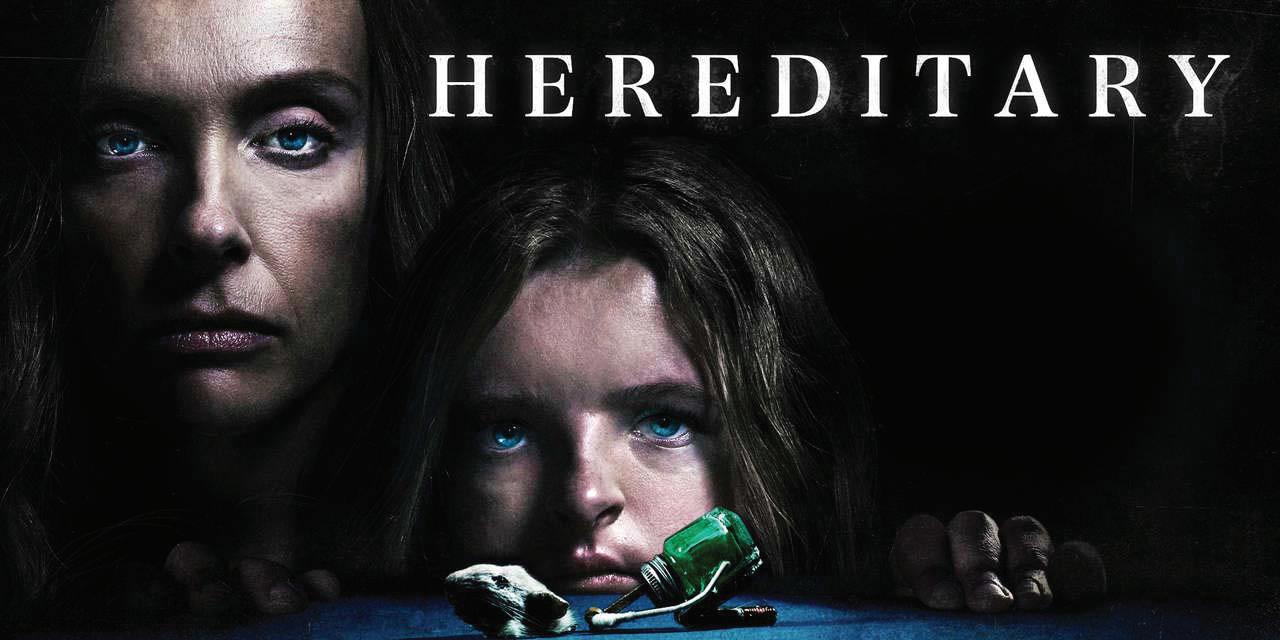
The plot was somewhat convoluted and complex, but it makes up for it with hairraising visuals that will make it nearly impossible to fall asleep. While Rotten Tomatoes ranked this movie second, I believe that it is the scariest movie on this list.
Overall, some of these movies were not as scary as the rankings given to them by Rotten Tomatoes, but they are all good movies, respectively. Though one may rather watch a more typical, exaggerated or stomach-churning movie with endless gore and violence, these three movies are still a great way to get in the spooky Halloween spirit.
mwinger@redwoodbark.org
Image courtesy of IMDb Page 15
HAVING WON TWO awards in various film festivals, the 2018 movie “Hereditary” stars Toni Collette, Alex Wolff and Milly Shapiro.
Image courtesy of Showtime
FOLLOWING ITS RELEASE, the 1977 thriller “The Exorcist,” was banned in some regions due to its content.
Photo by Sarah Goody
AWAITING TO BE tasted, the colorful drinks at Teaspoon bring a new palate to Corte Madera.
LAUGHING AT A video, teenagers flock to the comfy tables and chairs.
Photo by Sarah Goody sgoody@redwoodbark.org
Beginner-friendly classics you’re bound to love
By Ava Razavi
Inspired by my favorite TV show protagonist Rory Gilmore and her impressive repertoire of books, I decided to start reading classics at a young age. At 12 years old, I ordered “Swann’s Way” by Marcel Proust from Amazon because of its academic-looking cover. A week later, the book arrived (this was before everything was delivered within a couple of hours), and I cracked it open with excitement, read the first sentence and promptly closed the book. I had no idea what the hell Proust was saying, despite googling the meaning of his book for hours. It wasn’t for a couple of years that I dared to pick up another classic, then another, then another, until an obsession formed. Early on, it became clear that classic novels can be a hit or miss for young modern readers. To prevent a similar experience, here are my favorite beginner-friendly classic novels. P.S. Since all of these books are well-known, you will most likely be able to find nice copies at a local library or secondhand bookstore if you are looking to have sustainable reading habits.
Mary Shelly’s “Frankenstein”
This novel tells the beautiful narrative of a scientist named Victor Frankenstein who creates a monster from old body parts out of curiosity. He runs to tell his friend Robert Walton what he has done, but the monster disappears before he returns home with Walton by his side. The consequences of Frankenstein’s actions create a thrilling story of what happens when one takes the pursuit of knowledge too far. “Frankenstein” is a fantastic read, and in the novel’s 280 pages, the language is still straightforward for beginning

readers. Furthermore, this story has beautiful themes of rejection, hatred, greed and a familiar tale of the dangers of secrecy. The themes are skillfully integrated into the story and are guaranteed to stick with the reader for months after finishing the book.
F. Scott Fitzgerald’s “The Great Gatsby”
Perfectly encapsulating the 1920s, Fitzgerald’s novel tells the story of Daisy Buchanan and Jay Gatsby intertwined in a love story doomed to fail. Both insufferably rich and blind to the social issues occurring in the 20s, the duo lived through a series of lavish parties, excessive alcohol consumption and an unbelievable amount
there is a subplot of friendship between Buchanan’s cousin, Nick Carraway, and Gatsby, which Fitzgerald describes with just as much love as there is between the romantic couple. Arguably one of the most famous novels in American history, “The Great Gatsby” is also one of the most simple to read because Fitzgerald tells the story mainly through basic dialogue. Yet, despite its simplicity, Gatsby and Nick are characters with extreme complexities and developed storylines that make the book an entertaining read. Aside from the language, the themes within this novel are more applicable than ever, consisting of ideas of wealth inequality, love without bounds, the American dream and the fragility of life.
Ernest Hemingway’s “The Old Man and the Sea”
Okay, okay, according to my Goodreads account, I rated this book three out of five stars, but that rating has now been revoked and will be replaced with my thoughts from reading this book a second time around. Hemingway’s “The Old Man and the Sea” is the story of an old man who goes fishing. He stays on a boat for several days with a massive fish on his line, waiting for the perfect time to catch it. While this plotline may seem boring, the lessons taught through this short 127page novel are incredibly valuable. The themes of patience, persistence and pride are spelled across the pages. Lucky for any beginning classical literature reading, Hemingway was known for using simple language to tell a complex story, which he has truly perfected in this novel. That being said, I now officially change my rating of this book to five out of five stars for teaching me that all you need is a little patience, a cool head and an ungodly

MIXT your lunch up with some Sweetgreens
By Ella Kharrazi
As winds become brisk and rain clouds shield the sun’s warming rays, cravings for soup and warm sandwiches arise. People may begin to disregard the refreshing dishes they yearned for in the summer months. However, one must not ignore salads during the fall time, as several buildyour-own salad locations have opened in Marin, allowing customers to create salads containing any desired autumn ingredient. Check out any of these three salad places to add a delicious crunch to your fall!
Sweetgreen: 5/5

Equipped with umbrellas for outdoor seating, Sweetgreen in the Bon Air shopping center is surrounded by other popular stores, keeping the environment bustling and lively. Sweetgreen offers both preset salad menu options and custom salads, as well as warm bowls with the same modification choices. Sweetgreen further highlights seasonal bowls and salads, featuring ingredients such as warm wild rice and warm portobello mix. Although custom bowls come with only four free toppings, each additional topping is only 50 cents, and the base price is $9.95, the lowest out of the three locations. Moreover, despite having the least topping choices, the protein options are diverse
and inclusive to vegetarians and vegans, providing roasted tofu and steelhead in addition to two forms of chicken.
I tried Sweetgreen’s Guacamole Greens preset menu option. The bowl was generously filled, and an even amount of each topping laid on the bed of lettuce. The dressing I had requested on the side came in a container with enough for most all preferences, and the lime provided the perfect tang. I highly recommend Sweetgreen bowls, as they are not only pleasing to the eye, with an abundance of colorful vegetables and fruits, but they are also tasty and satisfy almost every craving with their plethora of custom options.
Blue Barn: 4/5
Across from student favorites World Wrapps and Starbird, Blue Barn is located in Town Center, boasting a rustic feel and variety of foods. Despite having plenty of indoor and outdoor seating, one has the option to order to-go and enjoy their meal at any of the other available seats dispersed throughout the continually vibrant and busy mall. Blue Barn serves 10 preset salads as well as a U-Pick salad, their customizable option. Although lacking the salad bar aspect of Sweetgreen and MIXT, Blue Barn yields over 50 toppings, six of which are free in the U-Pick salad. The base price for a U-Pick salad is $15.75, a higher cost than the other two spots, and it charges up to $7.95 for added protein. However, Blue Barn provides the widest array of proteins, offering three types of chicken, grilled flank steak, shrimp, king salmon, spicy ahi tuna tartare, bacon and tofu.
I ordered a classic kale Caesar salad with Grilled “Rooster” Chicken as an addition. The bowl was larger than the other two locations, accounting partly for the cost. Combining the vast assortment of fixings that cater to almost every taste and the flawless execution of the salad, Blue Barn’s costs may be worth it.
MIXT: 3/5
Contrasting both Sweetgreen and Blue Barn, MIXT, another salad bar, stands alone on the corner of East Blithedale Avenue. MIXT provides indoor and outdoor seating, and the tables and seats are decorated with

amount of knowledge about fish to get out of a sticky situation.
There are billions of beautiful novels out in the world, stacked upon each other, telling stories to whichever eyes dare to pick them up. I am proud to say I’ve read a good amount. Many of the narratives played out in my head quickly disappeared after a couple of months, but these novels above have stuck with me for years because of their timeless themes, developed characters and plain language. If you decide to read any of these and have any pressing thoughts, please share them with me; we can even start a book club!
succulents and green accents. However, the atmosphere of the restaurant may be its greatest feature. Although MIXT offers 50 toppings, and the base price for a custom salad is $11.95, less than that of Blue Barn, the quality of the food was not comparable. The bowl the salad came in was filled only halfway, and the “roasted” cauliflower hung limply. Additionally, only a minimal sprinkle of falafel crumble topped my salad, called Falaf on the menu, and the avocado was omitted completely. Besides these downfalls, MIXT has many protein options available, including bacon, tofu, grilled chicken, grilled flat iron steak, crispy cauliflower and crispy chicken, and every topping after the five free are $1, with no additional charge for even specialty items such as avocado. MIXT further gives the option to have the salad made in a reusable container the customer can keep, appending an eco-friendly aspect. Despite falling short on several factors regarding the salad itself, MIXT’s variety of ingredients and environmental consciousness deem it worth a try.
fiction novel, “Frankenstein” tells the story of when curiosity it goes too far.
arazavi@redwoodbark.org
REVEALING THEMES OF persistence and simplicity, “The Old Man and the Sea” is a wonderful beginner novella.
Image courtesy of Simon & Schuster
ARRANGED INTO AN
appetizing bowl, Sweetgreen’s fresh produce gives the salad both crunch and color.
Photo by Ella Kharrazi
DESPITE
MIXT’S ATTRACTIVE decorations, the salad bark Page 16 • Review October 28, 2022
Filling your knead for bread with Marin’s bakeries
By Bowen Rivera
Bread fills shelves at almost every supermarket in America, with hundreds of varieties and flavors. However, a couple of decades ago, bread was only available for purchase at local bakeries. Today, Marin still has many of these businesses, which proudly serve freshly made goods. Buying bread locally provides an opportunity to support these stores, while often getting a more delicious product than could be purchased in the average supermarket.
Flour Craft Bakery
Another Marin favorite, a popular gluten-free bakery, has two different locations. The original is in San Anselmo, with the second location having recently opened in 2018 in Mill Valley. Both bakeries serve an array of gluten-free bread, pastries and dessert. The bread is impressive for being gluten-free, but when compared to regular, gluten-containing bread, I found that the walnut sourdough didn’t compare. The walnut sourdough had excellent flavor, but texturely suffered without support from gluten’s elastic properties. Despite this, the bakery excels in its pastries, with both the spiced apple scone and the pumpkin walnut bread being an excellent choice for a morning snack. Another feature to note is the beautiful location of the bakery, located in the former location of Mill Valley’s lumber yard. Maintaining a rustic feel with plenty of outdoor seating, it provides a perfect location to sit down and have a coffee while enjoying delicious baked goods.
M.H. Bread and Butter
Located in San Anselmo, this bakery has the most expansive menu on the list, serving classic breakfast and lunch options in addition to housemade bread and pastries. This bakery’s bread has an incredible texture — perfectly chewy on the inside, even when toasted, with a crisp exterior. I felt that the flavor of the loaf lacked some of the depth provided by both of the other bakeries, but this was easily alleviated with a little bit of one of their flavored butters. Although I didn’t try the sandwiches, the soft flavor of the bread would likely pair very well. Their pastry was also quite good, perfectly flaky with a nice soft flavor. The blackberry danish was recommended and was simply excellent. The sour flavor from the blackberries contrasted perfectly with the sweet filling and the dusted powdered sugar on top. This bakery’s environment was really a selling point, with cute fall decorations and a view from the front counter into the actual bakery, providing a sense of accountability to the freshness of the bread.
Bordenave’s
Located in San Rafael and the oldest bakery on this list, Bordenave’s has been a local staple since 1918. This store is primarily known for its sourdough, which is phenomenal. The crust provides a perfect satisfying crunch with every bite, supported by the fluffy and slightly chewy interior. However, the biggest appeal to this bakery was the flavor of the bread, especially for someone who enjoys sourdough. The extra sour baguette provides enough flavor to be enjoyed by itself or with only a schmear of salted butter. On sandwiches, however, the regular
Stop getting all tied up over shoes!
By Shyla Lensing
As a cross country runner, avid outdoor enthusiast and salesperson of three years at local shoe store, Archrival Sports, I can confidently say I know athletic shoes. Across gait, width, support and drop, I can find anyone the perfect pair that matches their comfort and style. Thus, as one of Redwood’s resident shoe connoisseurs, I’ve put together a shoe guide for picking out the best pair depending on your foot shape, from higher arches to narrow heels, and athletic needs, whether you’re a hiker or road-runner.
First, familiarize yourself with some of this essential shoe and foot jargon. Oftentimes, these are the factors I look for when determining someone’s best shoe fit.
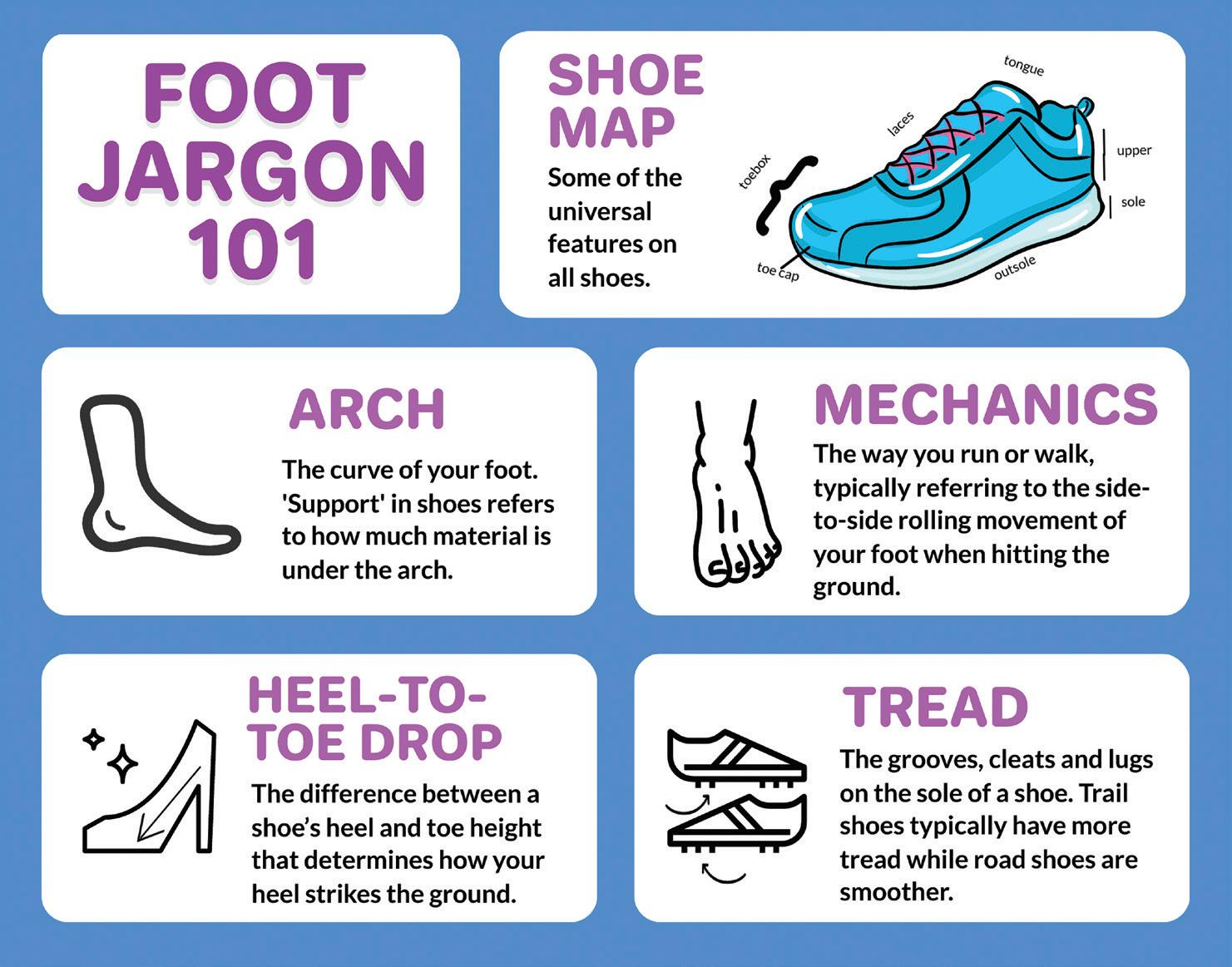
Arch: This is the curve of your foot. You can test your arch by dipping your foot in water, stepping on cardboard and studying the amount of the filledin footprint. Most people have normal arches (about a half-filled footprint), but flat/low (complete footprint) and high arches (large space between toes and heel) are also common. When a shoe has “support,” the support is often referring to how much material is under the arch.
Mechanics: The way you run or walk, typically referring to the side-toside rolling movement of your foot when hitting the ground. Naturally, the foot pronates, landing on the outer side and then rolling inwards, but some people can overpronate, putting heavy pressure on the inside of their foot. Other folks can supinate, landing on the inside of the foot and rolling outwards.
Heel to Toe Drop: Usually referred to as “drop” or “offset,” this measurement tells you the difference between a shoe’s heel and toe height and is measured in millimeters. Drop determines how your heel strikes the ground — higher drop shoes, which are found in more traditional trainers, encourages landing on the heel first, while zero or low drop shoes promote landing on the middle of your foot as you stride.
Tread: Look at the bottom of your shoe. The grooves, cleats and lugs on the sole are known as the tread. Trail shoes
will typically have a more intense tread on the bottom to grip uneven terrain, while road shoes are smoother.
Now that you’re versed in some shoe linguistics, here are some of my recommendations! One important note to keep in mind is that everyone’s feet are different. The only way to know if any of these shoes actually work is by trying them on.
Best All-Around Shoe — Brooks Adrenaline
Brooks is a sports equipment company that’s been an American shoe staple since 1914 and the Adrenaline is one of their best sellers! It’s incredibly popular at Archrival as well — and for good reason. The Adrenaline is a balanced shoe by almost all standards, with high-density foam that contributes to a durable and soft cushion, but does not collapse, thus offering a responsive ride that feels as if it’s contributing to the wearer’s energy. Brooks also employs their GuideRails technology to the Adrenaline, a valuable stability system that cradles the foot between two pieces of foam cushion in the midsole. Though more geared toward those with pronation, the medium support offered by the GuideRails can be beneficial
sourdough bread provides a perfect option, transforming the powerful sour flavor into a delicate supporting note. Additionally, Bordenave’s wholesale sales to stores across Marin and the Bay Area, making the bread even more accessible to consumers.
 brivera@redwoodbark.org
brivera@redwoodbark.org
limit lacing pressure. Overall, the Pegasus is a straight forward, mid-range, versatile comfort shoe (walk, run or sprint, it can do it all!) that will last the wearer months.
Similar shoe alternatives: Asics Cumulus (flexible, less cushioning, comfortable upper that locks heel in place); Brooks Ghost (stability oriented, larger drop so better for heel strikers, mildly responsive, for even more cushion try the Brooks Glycerin); New Balance 880 (heavier, more suited for longer distances/days, less durable, better grip); Hoka Clifton (super soft, lightweight, midsole rocker bottom).
to many. The shoe also has a Crash Pad, a shock absorber that minimizes tension and enhances smooth landings. Ultimately, the shoe offers a middle of the run compromise that can be ideal for anyone: nurses, crosscountry runners and even teachers.
Similar- shoe alternatives: Asics GT2000 (one of my personal favorites, less support, bouncy gel cushioning); New Balance 860 (firmer, more stabilityoriented with denser cushion); Saucony Guide (light stability, durable, slight rocker bottom); Hoka Arahi (small drop, rocker bottom, stiffer).
Best Neutral Shoe – Nike Pegasus
I’ve never been Nike’s biggest supporter, simply because I feel they outshine a lot of other notable brands due to their household recognition. But, I would be doing the running shoe world an injustice by not giving the Pegs, known as the “workhouse with wings,” the respect they deserve. The Pegasus is durable, light and has a ton of cushion, feeling as if your foot is being absorbed by a sponge (which becomes firmer as one breaks them in). They are neutral shoes, meaning they will work best for those who supinate or have moderate arches, and I’m also a fan of the thicker tongue on the newer versions that
Best Trail Shoe – Hoka Speedgoat Trail running and hiking encompass a whole range of other shoe niches that I wish I could explore. Alas, I will leave you instead with a trail shoe that’s hard to go wrong with: the Speedgoat, one of Hoka’s ultimate trail trainers. Hoka is widely known for its lightweight ultra cushion and low-drop shoes that tend to roll people forward by taking pressure off their heels (rocker bottom). The Speedgoat is no different, offering maximum cushion underfoot that absorbs the tensions of trail adventuring. The Speedgoat also includes Vibram Megagrip on the outsole, a tread that is manufactured for intense hiking shoes, offering a grip that can attack any terrain. Though the cushion strays away from traditional trail shoes with more minimalist features, the Speedgoat will ensure stability and prevent injury.
Similar shoe alternatives: Hoka Stinson (one level up in beefy cushion, for those who feel like moonwalking); Saucony Peregrine (a firmer, more shaped trail shoe); Brooks Catamount (geared more toward running, sleeker, lightweight); On Cloudventure (plush cushion, protective); Salomon Sense Ride (aggressive grip, stiff outsole, responsive).
Obviously, there are countless options in the world of shoes. This is just a brief overview of some of the best ones in my own opinion. Stop by Archrival Sports if you need a more in-depth and personalized look at your feet!
barkwww.redwoodbark.org Page 17 • Review
BORDENAVE’S FRENCH BAKERY has stayed in its original location since its founding.
Photo by Bowen Rivera
slensing@redwoodbark.org
Infographic by Shyla Lensing
How to be ‘ferry’ successful at the SF Ferry Building
By Claire Silva
Just a bridge away from Larkspur sits the San Francisco Ferry Building. Though once exclusively used as the city’s transportation hub, the Ferry Building is now known for the culture it harbors. Its large selection of goods and lengthy San Franciscan history has led it to become one of San Francisco’s most popular tourist destinations. However, knowing how to truly tackle the Ferry Building is still a skill that even locals have yet to acquire.
Transportation
Many Marinites may shy away from the Ferry Building due to its location.

While getting into the city may seem like a daunting task, the Ferry Building is relatively convenient if the right method of transportation is taken. Driving from Larkspur to the Ferry Building takes around 40 minutes with possible traffic. Parking offers an additional obstacle, as expensive garages are occasionally unavoidable due to the lack of street parking. To avoid the hassle of driving, taking the ferry is a great option. Ferries depart from Larkspur Landing, Tiburon and Sausalito, and run on a schedule found on the ferry’s website. It takes around 50 minutes to get to the Ferry Building by boat, which passes quickly while admiring Marin’s natural beauty. Tickets cost around $14 and can be purchased upon arrival.
Food
The Ferry Building offers a multitude of restaurants and food vendors, which can result in either an incredibly full stomach or a very overwhelmed mind. For those who may be intimidated by the large selection of eating options, here are some of the top spots to hit.

One of the Ferry Building’s most attractive features is its fast pace. The majority of the stores are grab and go, allowing for a quick bite while exploring the building. Daily Driver offers delicious, wood-fired bagels accompanied by curated butter and organic cream cheese, and makes for an affordable, yet delectable meal. For those in the mood for something a little more filling, try Golden Gate Meat
Local Kitchens brings variety to dinner
By Sydney Johnson
Each weekend, groups of teens are faced with a weekend dilemma: Where and when are they going to eat dinner, and will this decision cause a fight? Cravings go unsatisfied, suggestions are denied and while compromise is necessary, it is unfulfilling. Local Kitchens, a new micro food hall in Mill Valley, may have presented the solution to this problem. Micro food halls allow customers to purchase meals from a variety of popular restaurants in a space smaller than conventional food halls. Local Kitchens opened on Sept. 27 on East Blithedale and offers everything from falafel to burgers to sushi burritos. The takeout establishment is also open until midnight every night, a perfect concept for groups of indecisive teens. Come along on a journey to discover what Local Kitchens has to offer.
Oren’s Hummus’ “Hummus Chicken Bowl”
For those who enjoy Mediterranean or Israeli cuisine, Oren’s Hummus offers hummus bowls, pita sandwiches and more. The Hummus Chicken Bowl is light and mild. The hummus has a mousse-like consistency, but isn’t spectacular, and it may not impress a hummus lover due to its irregular texture and lack of flavor. On the other hand, the spiced chicken is delicious, moist and adds a satiating protein to the dip. However, the dish takes a downturn when it comes to the gluten-free pita, which tastes like Play-Doh. In the end, the hummus plate meets low expectations, but needs more flavor in all of its aspects. An added spicy sauce (optional condiments were listed during ordering) and regular pita could improve the meal. Overall, for an expensive base price of $16, the hummus plate is a mediocre dish, but Oren’s other top sellers have the potential to be much better.

Sushirrito’s “Latin Ninja” Burrito
Sushirrito, priding themselves on being the first sushi burrito brand, offers raw fish in various forms. The “Latin Ninja” burrito, seemingly Sushirrito’s take on Latin-Japanese fusion, is filled with bland ingredients and is seriously lacking in flavor, especially considering
its $16 price. The fish is overpowering due to the dull fillers, which include lettuce, rice, smaller rice pops and plantain chips. A daring concept, some Sushirrito burritos succeed in execution while others fall short. The highly rated “Sumo Crunch” burrito is impressive, an explosion of crab and shrimp tempura, all rolled in spicy tempura flakes. Though the “Latin Ninja” burrito itself isn’t spectacular, Sushirrito may be the new form of sushi that poke or raw fish fans have been looking for. However, ignoring the sauce options that can boost the burrito’s flavor may also be a vital mistake, which is foreshadowed by the various “signature sauces” that are available to add during the ordering process.
Fiorella’s “Pepperoni Pizza”
If Italian food cravings strike late at night, Fiorella’s Sicilian-style pizza may be just what one needs. This thick square pizza has an airy interior in its soft crust, which is paired with marinara sauce, mozzarella and spicy chili flakes to create a flavorful combination. This comfort
Company’s hot deli for a loaded sandwich. Or, grab some chicken, pork or beef from their butcher to take home. If you are a gluten-free Ferry Building explorer, don’t fear — the Ferry Building has plenty of options to satisfy your hunger. Mariposa, for example, is a completely gluten-free bakery with a beautiful spread of pastries and breads. You can end your meal with one of the many sweet treats found in the building. Just glancing at Dandelion Chocolate or Humphrey Slocombe ice cream will leave your mouth watering. Additionally, if you’re lucky enough to plan a trip on a Tuesday, Thursday or Saturday, you can stop by the exceptional farmers market right outside the front entrance, which attracts 40,000 shoppers each week.
Retail
While food may be the initial reason for a trip to the Ferry Building, it’s likely you’ll leave with a few shopping bags in hand. Unknown to most, many small businesses live in the Ferry Building and offer unique products that add to the experience. Fog City Flea Trading Post sells jewelry, houseware, art and apparel all sourced from the Bay Area, in addition to well-edited vintage that is rarely found elsewhere. You can stop by Maison Verbena to add a possibly unnecessary but beautifully-scented candle to your collection. The Ferry Building is also a great place to stock up on gifts to give, as it has everything from locally made olive oil to beautifully crafted tableware.
food may cause garlic breath and possibly indigestion, but is an impressive pie and is more exquisite than other late-night take-out pizzas. This gourmet-quality pizza has spice, but it isn’t overpowering with its airy base. It maintains a perfect balance between a rich sauce and a light crust. Though the pizza is $22, its eight pieces can feed many, and the quality reflects the price. Fiorella exceeds expectations, and Italian delicacies from the restaurant should also be explored.
Local Kitchens’ 126 dishes from eight different restaurants give food lovers the possibility to return several times without having to repeat the same meal. They also offer options from The Melt, Proposition Chicken, Wise Sons, The Plant and Humphry Scolombe – so the entire food hall has dishes ranging from mac n’ cheese sandwiches to bagels to salads. For whatever one may be craving, it’s clear everyone can find something to love here.
sjohnson@redwoodbark.org
CONTAINING A LIGHT but satiating flavor, Oren’s Hummus Chicken Bowl comes with gluten free pita and slaw.
Photo by Sydney Johnson
bark Page 18 • Review October 28, 2022
csilva@redwoodbark.org
THE FERRY BUILDING’S farmers market is loved for its fresh produce and delicious food.
Photo by Claire Silva
KNOWN AS A world class public food market, the San Francisco Ferry Building houses over 50 shops.
Photo by Claire Silva
sports sports

Daegan Cutter is one ‘hill’ of a cross-country runner
 By Maddie Sofnas
By Maddie Sofnas
After starting a race with nearly 150 runners next to him, senior Daegan Cutter is the only one in sight three miles later. But this makes sense. He’s ranked the 15th best cross-country runner in California according to PrepCalTrack and can run three miles in 14 minutes and 18 seconds. Even though he’s only been running cross-country for four years, Cutter is now a leader on the team and has become well-known among runners in California.
When Cutter was younger, he did not envision himself as a cross-country star. In fact, he only tried out for the team because soccer and mountain biking were not fall sports. Yet, because of his cardio-heavy past, he was able to excel in cross-country.
“During my freshman year, I needed a fall sport. Cross-country was the one because I was a skinny freshman and didn't want to do football. Though I [had] never really ran before, I fell in love [with the sport] and it's been my thing ever since,” Cutter said.
After an impressive freshman year, where Cutter earned second team in the Marin County Athletic League (MCAL), Cutter’s sophomore season was canceled due to COVID-19. However, the pandemic didn’t stop him from training rigorously to improve his times and running abilities. In his last meet as a freshman, Cutter ran three miles at a 5:30-mile pace. By the time his first postpandemic race came around his junior year, he drastically improved and ran it at a 5:06-mile pace.
Cutter’s cross-country coach, Nicole Graydon, explains that Cutter’s success is due to what he does outside of running.
“Daegan [has] always been good at knowing how to recover after runs. He wants to be good at [cross-country] and he understands what it takes. A lot of times it takes kids a while [to succeed] as they don't understand the other training parts involved that aren't me telling them to go run,” Graydon said. “That [understanding is] really what makes Daegan so successful.”
Cutter’s accomplishments and drive led him to become cross-country team captain in his junior year. His senior cocaptain Kai Peters has been his teammate since sophomore year and has seen his leadership grow.
“Daegan's a natural leader, [but also] a humble leader. He’s not super showy and he's not always yelling at younger kids. But [more] importantly, he's always there. You can always count on him. He's always putting in the work himself, which I think is really important in being a role model for the younger kids. He's a perfect example of what a cross-country runner should be,” Peters said.
Cutter’s hard work earned him second place in the MCAL cross country championship as a junior last year. This qualified him for the Division II North Coast Section (NCS) championship race, where he wasn’t favored to win. However, he took this as motivation, pushed through, came from behind and won it all.
“NCS was a really fun race. I actually wasn't feeling 100 percent that day, but even with [that hindrance], I went into [the race] believing I could win. At the starting line, they were talking about the favorites and I wasn't one of them,” Cutter said. “[At the beginning] I was with the front pack and I was thinking, ‘I'm gonna drop off’ and ‘These guys are so fast.’ That just kept going through my head. Then suddenly I looked around and there was [only] one other racer, and I thought, ‘Shoot, I can win this.’ The guy in front of me, I’d raced him a bazillion times and I just got the motivation and turned on the jets.”
Cutter credits much of his success to his encouraging team dynamic. His teammates are always supporting and cheering for him on the sidelines, which has contributed to his countless victories over the years.
“[All the runners] are really invested in the team and really
invested in each other. My teammates have their phrases, one being ‘Run with your heart’ and while it's kind of a joke, it makes you smile during your race and pushes you to keep going. It just reminds you of the team. Everyone cheers for you, and I cheer for everyone else. It's a good environment,” Cutter said.
With this great group dynamic, Cutter was optimistic about doing well in the 2021 Division II State Championship. However, right before the race, he got sick and was extremely lightheaded. While he still attempted to run, Cutter had to drop out within the first 100 meters of the course.
“I don't know if he would say it, but Daegan should have won state last year. The kid who he beat at NCS, took second at state, so Daegan deserved it. That was a really rough one. Hopefully he’s going to redeem himself this year,” Graydon said.
Cutter uses this setback as motivation to prove himself at states this year. He already placed 19th in the Men's Sweepstakes section of the Woodbridge Cross Country Classic in Irvine where he raced against the top runners in California. He also placed 11th at the Clovis Invitational at Woodward park – the same location as his future Division II state meet. He now looks to win both the MCAL player of the year award and NCS for the second time. Both aspirations have boosted his college recruitment process as he hopes to run at the collegiate level. His teammates and coaches are confident in him, and he knows that all the work he has put in will eventually pay off.
“Hopefully my biggest accomplishment is still coming,” Cutter said. “I’m hoping for a state championship this year. I think I can go back and show what I should’ve done last year. That’s motivational.”
Sports analyst Sam Zlot is way above average
By Isabella Wagner
Stomping, clapping, chanting — the noise of the screaming fans drown out the referee’s whistle. Cheerleaders raise their pom poms and a football spirals through the air into the welcoming hands of a wide receiver.
Amidst all of the action, there is a behind-the-scenes worker seated in the towering red press box above the bleachers: senior, and football team sports statistician, Sam Zlot.
Nearly two years before, Zlot’s enthusiasm for both mathematics and sports sparked his interest in sports analytics, a practice where statistics are applied in real life. His fascination only furthered when he participated in a sports analytics class at Tulane University in the summer of 2021, prior to his junior year.
Inspired by his newfound knowledge, Zlot approached the varsity football coaches at the start of the 2021 season about compiling play-by-play statistics and analyzing film breakdowns for the team. The coaches accepted this request and allowed him to start working with the football players.
“At first, the [coaches] were pretty skeptical because they hadn’t really used any analytics or statistics before. It was a lot for them to understand what I was doing and how it could make an impact,” Zlot said.
After receiving approval from the coaches, football games became a busy scene for Zlot. Throughout the four quarters, he critically watches the Giants and their opponents, all the while giving insight to the coaches.
“During the game, I have my computer and spreadsheets going, to figure out if [the team] is running the ball
to the right more, or if they’re running the ball to the left, or passing it really well,” Zlot said. “And then after the game, I’ll come back with more in-depth stats; for example, maybe we ran a certain play too many times which is why the [opponent] caught on.”
Zlot first excelled in his position in the third football game of last season when the coaches finally decided to utilize his reports in their game plan.
“I told [the offensive coach] some insights on what direction to run the ball, and the next play was a run to that side. That was a big [moment] for me [because] I gained trust with the coaches,” Zlot said. “My favorite thing is [the coaches] using my work and putting it into the game plan and having it be successful.”
Assistant head coach and offensive coordinator Estevan Chavez recognizes Zlot’s hard work and explains the role Zlot plays in aiding the team.
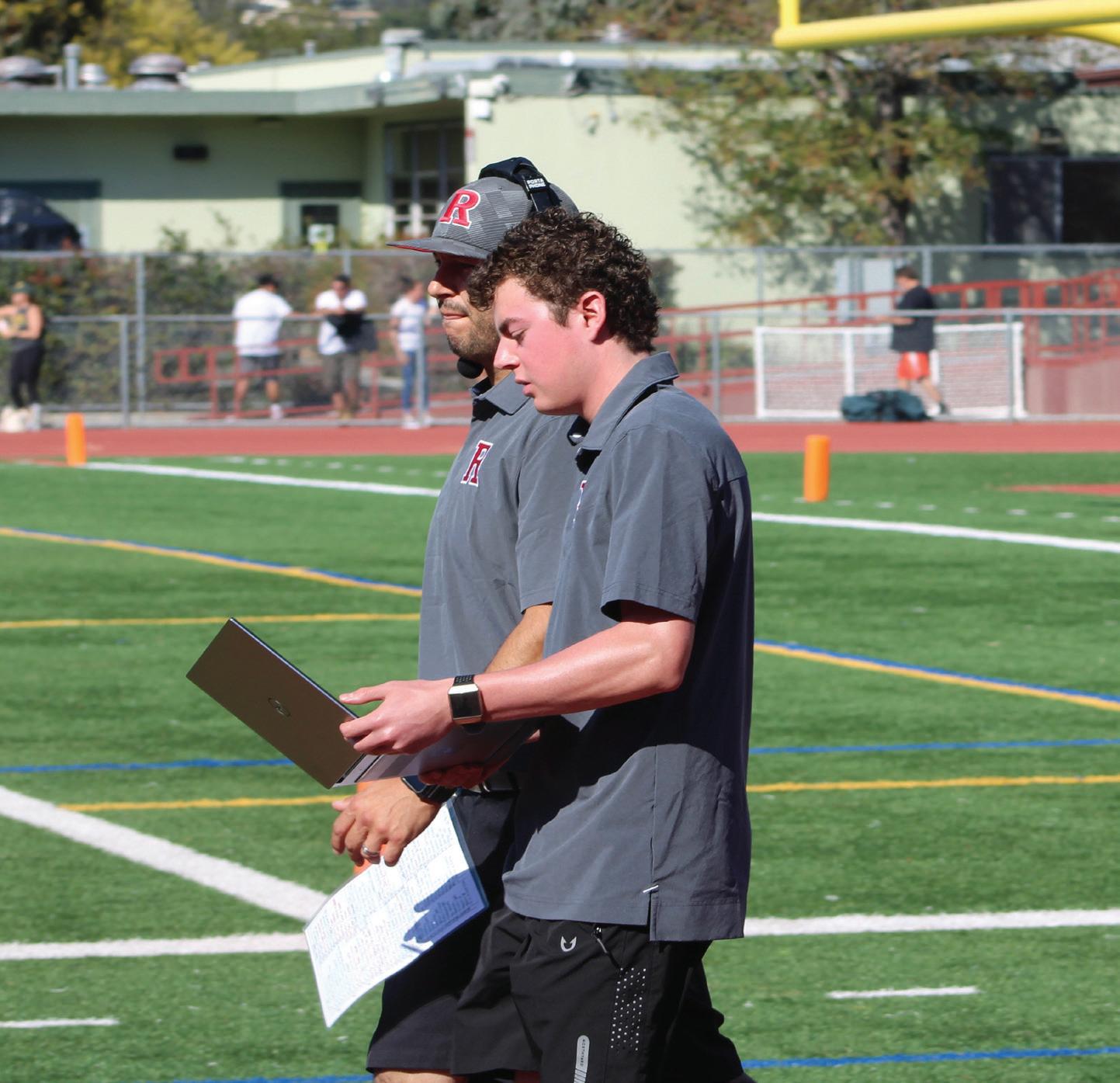
“When I [put] our film on Hudl, [an app that works to capture and analyze videos], [Zlot] will go through our plays and break down our tendencies,” Chavez said. “In doing this, [Zlot] helps us figure out what is working for our team and what is not working.”
By tendencies, Chavez refers to the Giants’ play habits and the runs or tackles they most commonly execute.
Zlot not only focuses on the Giants’ plays but also creates scouting reports on the opposing team so that the coaches can strategize for their upcoming games. This preparation is appreciated not only by the coaches but by the players as well. Senior and football captain Sam Janowsky expresses the importance of Zlot’s role in aiding the Giants against their opponents.
“With [Zlot] we’ve been able to understand the other teams’ schemes better
and it’s just been helpful all-around. We know when we should run versus pass, or blitz versus not blitz,” Janowsky said. “All those things help us win the game in the end.”
Zlot’s hard work demonstrates his dedication to both the coaches and players, which allows him to be recognized as a welcomed member of the team. Chavez acknowledges the effort Zlot has put into his position.
“[Zlot] to me is definitely one of the players on the team, and he’s treated that way. He’s helped us out in a lot of ways, more than I can explain,” Chavez said.
Zlot’s skills do not stop with high school football. Recently, he has been in contact with the National Football League (NFL) Cincinnati Bengals’ analyst, gaining insight about how to improve his own
role as a sports analyst. With hopes of continuing sports statistics at whichever college he attends in the future, Zlot’s connections and work are setting him up for success.
As Zlot’s final high school football season as a sports analyst continues, he reflects on his experience and what it has provided for him.
“I’ve learned how to communicate a lot better with different types of people,” Zlot said. “I’ve also learned a lot about statistics through a lot of trial and error, figuring out how to excel and how to visualize data.”
Page 19
PACING ALONG THE sideline, Zlot discusses plays with the coach at halftime.
Photo by Isabella Wagner
msofnas@redwoodbark.org
Photo courtesy of Eric Cutter
Record-breaking mountaineer Hilaree Nelson passes away
By Gillian Reynolds
On Wednesday, Sept. 28, famous mountaineer and skier Hilaree Nelson was found dead after a fall off the Himalayan Mountain Range in Kathmandu, Nepal. Nelson was skiing with her partner Jim Morrison when rough weather conditions led to an avalanche that separated them. She left behind Morrison and her two sons. Nelson was an extreme skier, whose inspirational career lasted over 20 years. In 2012, she became the first woman to summit the 8000-meter peak, Mount Everest, and the adjacent Lhoste mountain within 24 hours. In 2018, Nelson received the National Geographic Adventurer of the Year Award. In her career, she embarked on over 40 expeditions in over 16 countries.
Tamalpais High School senior Drake Miller is an avid skier and mountaineer who has tracked Nelson’s social media and her overall progress since she first skied Mt. Everest and Lhotse, and admires her accomplishments.

“[Her death] really struck me because I’ve been following her skiing for several years now, [and] she’s done some crazy stuff. [Everything] she does is deathdefying,” Miller said.
Miller first started following Nelson after she and Morrison skied Lhotse. He was impressed, especially with Nelson being a woman who was performing at such a high level in a male-dominated sport.
“Not many women are huge in the ski and mountaineering community, and [Nelson] was just someone who stood so far ahead of every man [and] every woman. She was out there crushing it,” Miller said.
Those who worked closely with Nelson saw her success behind the scenes and knew her as a kind and committed person. Matt Sharkey, Chief Brand Officer for Into Technologies, became close friends with Nelson in 2018 when he was the Global Director of Sports Marketing at The North Face, and got to know her better when she
joined the North Face Team, a global elite team of athletes across outdoor disciplines. He watched her grow as she pursued a career in alpinism, the climbing of high mountains and alps.
“I think one of the most remarkable things about [Nelson] is how humble she was as an individual when questioned about who she was and her pursuits, yet [was] fiercely determined to accomplish the most incredible things in alpinism ever. You don’t really see that duality in too many individuals,” Sharkey said.
Nelson specifically left an imprint for women in the sport of alpinism and paved the way for many other influential women in mountaineering. She not only dominated the sport as a whole, but inspired people to pursue their dreams and to not be afraid to challenge themselves.
“Without question, she’s the most accomplished female alpinist of her generation, and I know that she was proud of that and she was honored to be a mentor to other women in a sport that had been predominantly dominated by male and patriarchal culture,” Sharkey said.

The ski industry, described by Sharkey as what used to be an “old boys club,” had been used to characterize many sports cultures. Yet, Nelson did not await permission to represent women in the outdoors or to challenge herself.
“She was not cavalier at all about what she did in the mountains. She was highly calculated and highly prepared and trained very hard for everything that she ever went out and sought to accomplish,” Sharkey said.
As someone who watched Nelson from a professional standpoint but also grew to know her as a close friend, Sharkey saw her become a role model for the mountaineering community itself. He emphasizes that her inspiration will carry on through coming generations.
“She’s a hero to me on a personal level, and that has absolutely nothing to do with her gender and has everything to do with
who she was as a human being. … It will not end with her. [Her great-grandchildren] will still be talking about the incredible human being that she was,” Sharkey said.
Nelson made those around her feel constantly inspired and appreciated. Professional skier Hadley Hammer further illuminates how special Nelson was after first meeting her on the North Face team, similar to Sharkey’s experience of getting to know her on the same team.
“[Nelson] always felt like more of a big sister to all of us. … She was just a really down-to-earth human,” Hammer said.
Regardless of gender, Nelson’s accomplishments and expeditions were groundbreaking and pushed boundaries that had never been challenged before. Despite the dangers, Nelson continued to be drawn to the mountains. Hammer felt that the familiar feeling of attraction and love for the mountains kept Nelson going.
“First and foremost, that joyfulness of skiing really kept her in the mountains, and I think she was always curious about what
she was capable of. … She had no reason to stop,” Hammer said.
Hammer describes Nelson as a leader who demanded to be treated the same on each expedition as anyone else. Nelson’s sureness in herself continues to inspire people and show the importance of pursuing what you love while staying true to who you are.
“She was an incredible person that led her life [in] her [own] way… She knew who she was and I really respect her for that,” Hammer said.
Nelson’s bravery, kindness and inspiring actions will continue to prove how exceptional she truly was. Known as one of the best mountaineers of her generation and an extreme influence who changed ski and mountaineer culture for the better, Nelson lives on through her legacy.
greynolds@redwoodbark.org
Students hit the slopes on competitive ski teams
By Mayson Weingart
When the first snowflake falls in Tahoe, students rush to the mountains with friends to hit the slopes. While some ski as a pastime, others have dedicated themselves to competing and live for the thrill of speeding down the mountain. The dedicated skiers that do not live in Tahoe have to work further to compete against the kids attending ski schools.
Learning how to ski at two years old, senior Will Sohn quickly found his love for the sport. He is a member of the Free Ride competition team at Palisades, a ski resort formerly known as Squaw Valley Alpine Meadows. Sohn and his teammates specialize in a form called freestyle, where they drop off of cliffs and get evaluated on how successful they complete turns and tricks and the freestyle course they carve on the slope. Although Sohn is now a dedicated and passionate skier, he was originally reluctant to begin the sport. It was his parents who were the ones who encouraged him to give skiing a try.
“I originally started skiing because my mom forced me to. She kind of just slapped a pair of skis on me and was like, ‘Alright, there you go, good luck!’Apparently, she knew what she was doing, because all of the sudden I started to fall in love with it more and more everyday. I just genuinely enjoyed every aspect of the sport,” Sohn said. “Then I decided to take it to the next level by going to competitions and pushing myself to be the best I possibly can. Now it’s evolved to become something that helps relax and excite me.”
Although competing has become something Sohn enjoys tremendously, dealing with nerves before races is a feature of skiing Sohn has learned to handle over time.
“When I’m figuring out which path I’m going to take during my races, I always look up at the run from the bottom of the mountain. I visualize in my mind which turns I’m gonna make, basically just making a game plan. So when I’m getting ready to go, and sitting at the top of the venue, I’ll already have everything figured out,” Sohn said. “To distract myself, I love to cheer for my teammates and focus on what they’re doing instead of what I’m about to do. Taking deep breaths and staying calm is always extremely important, because panicking is the worst thing you could do.”
Meeting several of her closest friends through the
sport, senior Alexis Cartwright has also been able to connect with the sport on a more personal level. Although she is not currently on a team, she skied for the Alpine Big Mountain Sport team at Palisades for three years, and has been skiing with her family for most of her life.
“Ski team taught me to enjoy the sport and fixate less on being perfect, and also fostered a lot of new friendships. There’s a huge learning curve, and simply enjoying the
beautiful scenery and opportunity to be outside started to matter to me a lot more than winning,” Cartwright said. “Just being up in the mountains is such a soothing experience, especially when you’re surrounded by some of your best friends. I now have friends down in Redwood City that I never would have connected with if I didn’t take a chance and try out for the team.”
Above all, Cartwright expresses her gratitude for the personal growth the sport has gifted her.
“I’m a perfectionist. When I was on a team and skiing next to kids who were way better than me, I was kind of humbled. It taught me that it’s okay not to be the absolute best, as long as I’m enjoying what I’m doing,” Cartwright said.
Also starting the sport at a relatively young age, junior Maddy Marron loves how ambitious skiing makes her. Marron has been a member of the Downhill Alpine team at Palisades for three years; she and her teammates are graded on their technique in completing an approximately 60-second course. After doing the sport for so long, she, like Sohn, has developed routines on race days that help her succeed.
“The day before a race, we always have a team meeting. Preparing well is super important, so we talk about sleeping well, stretching, hydrating and eating healthy. That way when we get up in the morning we are full of energy and ready to support our teammates and really get after it. Everyone is always in great spirits and it makes the whole experience so special,” Marron said.
For anyone looking to passionately ski, Marron advises to evaluate one’s time against one’s love for the slopes.
“You need a lot of time, you need a lot of motivation and you need a lot of passion if you want to ski competitively. It’s a big sacrifice of time, making the drive to Tahoe from Marin. It gets especially hard when I have a lot of homework or I miss out on things at home,” Marron said. “But if you truly love the sport and are naturally an extremely competitive person, I encourage you to keep pursuing it.”
mweingart@redwoodbark.org bark Page 20 • Sports October 28, 2022
MAPPING OUT HER next move, Nelson adjusts her gear during a grueling expedition.
Image courtesy of Adventure Equipped
TRAVELING TO ALASKA to ski, Will Sohn completes a backflip while enjoying the beautiful scenery.
Photo courtesy of Will Sohn
Varsity boys’ water polo trio commits to DI schools
By Gemma Favaloro
Last fall, the boys’ varsity water polo team dominated their season with a 26-6 record, ending with a Northern California Section (NCS) title. However, Redwood water polo does not only produce winning titles — the program has also assembled an incredible force of Division I (DI) athletes within the 2023 class. In fact, Max Matthews, Charlie Mills and Billy Zech have all recently committed to DI schools. This success has come from their leadership in and out of the pool.

The team’s winning record and abundance of talented athletes sparked interest from recruiters. Goalkeeper Mills, who recently committed to the University of Southern California (USC), recognizes this and attributes his success in the recruitment process partly to the competitive environment within the team.
“[Matthews] and [Zech] are some of the best players that I play against, so I think all of us help each other when we hop in the pool and shoot at each other. It’s an iron-sharpens-iron situation there [in the pool],” Mills said.
Zech committed to the United States Naval Academy in April 2022. Zech shared a similar sentiment to Mills when describing the trio’s chemistry. However, he also highlighted the team dynamic which has enabled them to be successful and work hard in efforts to improve.
“Our practices are very hard in high school [and] were especially [challenging] in club [water polo] sophomore year. We were [practicing] from 6 a.m. to 6 p.m., so we’ve put in the hours to [be successful]. But I also think [we accomplish so much due to] the amount of time we spend with each other and how much we like each other,” Zech said.
This sense of ongoing dedication and drive is present within the Redwood water polo team, which will benefit Zech, Mills and Matthews in their future water polo and academic careers.
“My coach always says that hard work beats talent. If you put in the work, you will get better,” Zech said. “There are a lot of [people who have] natural talent and [don’t] work hard to get there, and these people will never get places. But if coaches see that someone is working hard, and that they can develop into a better player, they view that as something that [is beneficial] in water polo and school. The more hours you put into trying to learn
something, the better you seem to do.”
Center defender Matthews, who committed to the University of California Los Angeles (UCLA) in September 2022, stated that this team has helped him gain life skills over the last four years that will benefit his career as a collegiate athlete.
“[I’ve gotten better at] learning to be a leader and teammate. I think the water polo stuff kind of comes naturally. There’s a ton of other stuff outside of the pool … [such as learning] time management, [which water polo has taught me]. If you can manage school and sports well, you never feel like you’re burning out. That’s probably the most important thing,” Matthews said.
Being a student athlete takes rigor and determination, hence why the commitment process differs from player to player. Each athlete is looking for different attributes in a school, both academically and athletically. For Matthews, the decision to commit to UCLA went relatively smoothly.
“I was set on UCLA from the start. I’m 4th generation, it’s an amazing school and I’m super excited. … It wasn’t a hard choice,” Matthews said.
Even though UCLA and USC are rivals, Mills shares similar sentiments to Matthews about his decision.
“I just love the people down there, and I love the school. I’ve always wanted to play [water polo] in Southern California, so all that excites me,” Mills said.
Most commits are focused on balancing school and their sport, but for Zech, his commitment to the Navy goes beyond playing DI water polo and going to a competitive university. Zech will serve in the Naval Academy, which has been his passion since he was little. The skills he has gained from water polo will ultimately help him thrive in the Navy. He states that being a leader is vital in the Academy, since you are thrown into the position of naval officer upon graduation.
“If you’re [used to] leading, it’s better for you later on in life, and it will help you develop as a person,” Zech said.
All of these athletes still want to continue to achieve milestones at Redwood, before they leave high school behind.
“[This season is] one last chance to play with the guys before we all go to college. Hopefully, we can take down our rival, [Archie Williams High School]. They’ve beaten us the past couple of years, and [beating them has] been a major goal of ours,” Mills said.
The trio hopes to leave an impact and see results from
Opinion: One bad apple ruins the bunch
 By Lauren Poulin
By Lauren Poulin
Pass, set, hit. Those are the three words I find myself continuously chanting to the 8th-grade girls’ volleyball team I
championship season, head coach Nick Saban recognized his team’s ability to overcome the challenges of COVID-19 in an article by Saturday Down South, an organization that covers Southeastern
“This team had tremendous togetherness; they overcame tremendous adversity. I told them early on, ‘Whoever handles the disruptions of COVID-19 is going to come out on top in the end.’ And I couldn’t have been more proud of the way this team did everything they needed to do,” Saban said.
How well a team responds to adversity comes directly from a team’s ability to work together.
on the team to be fully focused. This same principle applies to any team sport. One teammate’s negative energy can plague an entire team with distraction, distrust and animosity. Negativity on a team can be the defining factor between success and failure. Therefore, when choosing teams, coaches need to consider not only players’ skills but also their team compatibility, sportsmanship and attitude.
Teamwork matters more than ever as sports recover from prolonged disruptions during the pandemic. At the end of the University of Alabama football’s 2020
If teammates lack basic respect for one another, they will be unable to overcome the various difficulties that playing sports presents, from competing against a cutthroat team to uplifting one another after tough games. However, just one “bad apple,” or negative person on a team can create this toxic environment for everyone else playing. According to a study by researchers from St. Mary’s University on problematic and disruptive players, negative teammates can have a damaging impact on teams, building negative role modeling and lower team morale.
An October 2022 Bark survey found similar results: 85 percent of students thought it was important for teammates

the hard work they have dedicated to the sport over the past four years.
“[We want to be] undefeated in the Marin County Athletic League (MCAL) and win the championship. We’ve put in a lot of effort this year, and I definitely think we can do that,” Zech said.
gfavaloro@redwoodbark.org
to get along. Many students value an environment where teammates avoid conflict and demonstrate kindness towards one another.
In an article by Football Today, Mark Odin, the defensive coordinator for Claremont McKenna College football, explained attitude can be a defining factor when recruiting players for his team.
“I will not recruit someone with a bad attitude because it projects negativity… When people have bad attitudes, it impedes growth and progress. Poor attitudes also typically stop creativity and/or set boundaries to what one can accomplish,” Odin said.
However, considering character while recruiting is a controversial subject. The main goal of any sport is to win games, not necessarily to get along. Nonetheless, team dynamics play a tremendous role in whether a team will succeed. A study done in the Journal of Sports Sciences by researchers from the University of Western Ontario, McMaster University and Wilfrid
Laurier University assessed various club soccer and university basketball teams in order to compare cohesiveness to winning percentages. The study found that there was a positive relationship between teamwork and success as teams that were more united had higher winning percentages. In turn, teams may not perform well without every member in synchronization, making compatibility necessary for all teams.
To avoid the “bad apple” in sports, coaches must be on the lookout during tryouts for players displaying negative attitudes. When deciding between certain players for a team, coaches should always choose the player who is a better teammate, lifting their peers up instead of bringing them down. While skill is still essential, the ability to improve and grow as an entire team is far more valuable than one player who might lower the team’s positive energy.
lpoulin@redwoodbark.org
barkwww.redwoodbark.org Page 21 • Sports
WARMING UP, ZECH winds up to take a powerful shot on Mills.
Photo by Arjun Aujla
Illustration by Lauren Poulin
lifestyles lifestyles
Tanya Khandheria drives toward a future in biotech
By Lily Reese
“I’ve always been interested in the medical field. But more recently, I’ve started learning more about [biotechnology]. I just thought it was really cool how many doors it [has] opened and the fact that it hasn’t really been explored much. There’s so much untapped potential there,” senior Tanya Khandheria said.
Taking on the medical field one biotech data point at a time, Tanya has spent the past few months writing a medical paper focusing on Parkinson’s disease as well as solutions to the disease through biochemistry, a process where genes and other biological areas are chemically altered in order to help or mitigate disease and other genealogical effects. During her research, Tanya found GEn1E Lifesciences, a local company working to advance treatments for rare inflammatory diseases, and began an internship, hoping to turn her passions into real life experiences.
“I reached out to [GEn1E Lifesciences] and sent them my paper and a cover letter, and they were like, ‘We would love to work with you.’ So, over the summer and into the school year, I started driving down to Mountain View, where their lab and office are, and I started working with them,” Tanya said.
She describes the work she has been able to do while working with specific proteins like the mitogenactivated protein kinase (MAPK) and other neurological pathways that biochemistry and biotech work with to create change in genes.
“[The company] looks into neurological pathways — things like the MAPK pathway. And these are the pathways that certain illnesses use to get into your body. So we look at things like Parkinson’s [disease], which is particularly what I’m working on, but also other [diseases such as chronic obstructive pulmonary disease] and lung cancer. They all use certain pathways, so what we’re looking into is preventing diseases from that sector,” Tanya said.
Although working in Silicon Valley has become a major time commitment during an already busy senior year, Tanya stresses the importance of the work that she is doing.


“WHAT I FOUND is that it’s not as difficult when you love what you do and love the people you work with. I honestly feel so lucky to be able to do [biotech work] with this little experience,” Tanya said.
“I think the important thing is boiling down [what doesn’t] matter and retaining the things that actually have value. Now, I think everything in my life is meaningful in terms of the work I do. I don’t do any busy work; I don’t take classes I don’t love; I don’t hang out with people [that I don’t love]; I don’t do things that I’m not super excited about,” Tanya said.
Since Tanya is a minor, there were various hoops she had to jump through to attain such a sought-after position. California is one of the few states with stricter laws on minor labor as well as regulations in the biotech
field which protect Tanya, ensuring that she and other minors are not being overworked and under-supported. Legality also establishes that GEn1E Lifesciences is not violating ethics surrounding testing on animals and patients.
Oliver Lowndes, a senior and friend of Tanya, has watched her not only thrive in school but also throughout her journey in biochemistry.
“[Tanya’s] work ethic is crazy. She’s always working. Whenever I text her, ‘Hey, what’s up?’ or ‘What are you doing?’ she responds with, ‘I’m working on this project, and we’re getting this figured out.’ She is always getting the job done,” Lowndes said.
Through the help of her friends, parents and counselor, Elijio Arreguin, Tanya was able to construct a schedule to prioritize her work. With Arreguin’s assistance, she was able to waive five of her seven classes and replace them with her internship. Other staff members as well as her parents have recognized the valuable qualities that Tanya exerts as a student and as a young adult, including her father, Ajoy Khandheria.
“I believe that she is so driven. I’ve seen many things that she has done that show she’s very inquisitive. … Her intellect is off the charts,” Ajoy said. “While she is very driven about [her work], the other thing is that she’s a [social] person. She spends between two to twoand-a-half hours in the gym every day, and she also likes to be with her friends.”
With more time available outside of school due to her small class schedule, Tanya is able to obtain real-life work experience from GEn1E Lifesciences, frequently sitting in on board meetings and data work, while most other people in her field are well out of college.
“I am fighting the battle of, ‘Do I want to work really hard on college apps and try to get into the best possible college, or do I want to just drop the whole college application process and just go to college for two years because I’m already working my dream job domestically?’ I love the people I work with, and I love what I do,” Tanya said. “I honestly feel so lucky to be able to do it with this little experience.”
lreese@redwoodbark.org
Teaching without restraints: Dr. Sapio’s past work
By Lili Hakimi
“Before I first walked into the facility, there was some degree of fear and uncertainty. I didn’t know what I was getting myself into. I remember getting ready to go to the first class and one of my family members asking [if] my students [were] going to be in handcuffs. I didn’t know the answer to that question before I walked in,” Dr. Jennifer Sapio said.
Before coming to Redwood in 2021, Sapio, an English teacher, taught inmates at the Travis County Correctional Complex (TCCC), a prison in Texas. She was inspired to teach there due to her family’s past interactions with law enforcement.
“One of my sisters experienced a long struggle with opioid addiction, which I have been pretty open about sharing with my students and colleagues because it is a relevant issue that affects many people. My sister was incarcerated at [TCCC] and that’s how I became familiar with the location,” Sapio said.
Due to this conflict of interest, she was unable to participate in TCCC’s teaching program while her sister was incarcerated.
“After she was released, I felt compelled to give my time, energy and expertise in this place where so many other [people’s] family members were still incarcerated,” Sapio said.
Additionally, Sapio described her
time teaching at the TCCC as one of her favorite teaching experiences. She explained how the best part about working at the prison was watching guests visit loved ones.
“Witnessing that with your own eyes and to feel deeply how so many families were being impacted [by incarceration] was really powerful,” Sapio said.
Junior Cece Wiener, who had Sapio as a teacher during her sophomore year, has observed her empathetic teaching style.
“She is willing to connect with her students on a personal level rather than just a teacher-student level. She really wants to be there for her students and support them in the best way she can,” Wiener said.
Emily LaTourrette, a co-worker and
friend of Sapio, says she is unique in the respect that she is a genuine, positive person.
“She has this calming energy about her that has to do with patience. She’s a great listener. All those things make a huge impact in a classroom and on the students,” Latourrette said.
In terms of her students at TCCC, Sapio taught a variety of ages. However, for her, there was one student that stood out in particular. In her first class, the students were reading Fyodor Dostoyevsky’s novel “Crime and Punishment,” and at the end of the class, Sapio had an eye-opening conversation with this inmate.
“He drew comparisons between the character in the book and himself. He had been arrested and charged with murder,” Sapio said. “My student said to me on the last day of class, ‘That’s my crime, and that’s my sentence, as well.’ That was the first time I had ever heard a student talk about their alleged crime.”
For Sapio, this was a powerful moment because she had already developed a close relationship with this student throughout the course.
“I’m so glad I got to know him in all of those ways for those weeks before he said that. It really broke down any kind of prejudice or stereotype I had in my mind around the challenges that we all face as humans, and the difference between those who are on the inside [of the prison] and those who are on the outside,” Sapio said.
While Sapio’s experience working in
a prison was informative for her, she says our society still perpetuates harmful stigmas surrounding incarcerated people.
“We can’t look at the stereotypes without also understanding the prison industrial complex, the history of incarceration and how inequitably the consequences are experienced by marginalized groups. Part of the stereotypes around incarceration are also stereotypes around race and social class.” Sapio said.
Furthermore, Sapio explained how during her time teaching classes at TCCC she learned how similar the learning environment was across different groups.
“What brought us together was our curiosity and excitement to discuss material together. We sat in a circle, had our books open and our pencils active,” Sapio said.
The similarity in learning environments from traditional teaching in a classroom setting to teaching at TCCC helped Sapio overall experience a shift in mindset.
“As a teacher, we say and hear things about the democracy of education and about honoring every voice in the room as a dignified human,” Sapio said. “We hear that, but it is a different thing to implement that every single day and to deeply believe and abide by it. [Because of TCCC] that switch has been flipped for me.”
Page 22
lhakimi@redwoodbark.org
BEFORE COMING TO Redwood, Sapio taught inmates at the Travis County Correctional Complex.
Photo courtesy of Jennifer Sapio
Teachers substitute in new opportunities
By Kate DeForrest
The sun streams through the windows, lining the halls while laughter echoes through the classrooms. The sounds of hundreds of footsteps flow through the doors and someone sits at the teacher’s desk, one small packet laying before them, detailing today’s lessons.
A substitute teacher’s role is to fill in the gaps in schools when a teacher is unable to make a class. According to the U.S. Bureau of Labor Statistics, 59,270 short-term substitutes currently work in California, the most in any state. While there are many reasons to become a
been teachers in the past. Lisa Tribolet stopped her full-time job as a teacher when she had her three kids. As they grew older and more independent, she decided that she wanted to return to the classroom.
“If I worked as a full-time teacher [right now], taking days off would be challenging because then I’d have to come up with lesson plans and actually find a sub, which we’re short of right now. So this way [as a substitute], I can just take off days and go see a kindergarten performance or go on a field trip with my third grader,” Tribolet said.
While Tribolet decided to try the profession for the flexibility, Gary DeTore decided to substitute after retiring from teaching full-time at Redwood for 30 years. He has found that substitutes and teachers, while similar, have very different roles in the classroom.
“Teachers have more responsibility towards their colleagues, to the administration, to students with special needs [and] to contacting parents. A sub doesn’t have any of that. They just monitor the students and make sure they’re doing what their teachers assign them,” DeTore
Like Tribloet and DeTore, Madeleine Metzger was also a teacher before becoming a consistent substitute for the LarkspurCorte Madera School District. MetzterGeloso can enjoy being a substitute more easily than working full-time because she, like Detore, finds the burden of responsibility towards other teachers and students to be lighter. However, one of the most challenging parts of the job is its unpredictability.
“You’re there to provide stability and to get the kids to do their work based on the lesson plan that the teacher has left. [But], sometimes I go in and there’s no lesson plan, so you kind of have to wing it,” Metzger said.
Tribolet also struggled with maintaining control of an uncertain classroom when she first began substituting, especially when unfamiliar with class rules. However, because of her experience, she has become more comfortable and flexible with her job’s daily chaos, which greatly differs from the more rigid expectations when she was teaching full-time.
“[When I was a teacher,] I kind of expected the subs to do exactly what I wanted them to do. And now being on the other side of the fence, I realized that that’s totally unrealistic. Because you kind of have to read the crowd or someone might have a meltdown, you might have to deal with that and you might not get something done,” Tribolet said.
In addition to the difficulty of maintaining a class, it is often challenging for Tribloet and Metzger to build relationships with students, especially when they are only in a class for a few days. Metzger notices that having small conversations can help make genuine connections. For DeTore, asking questions is one of the most important parts of creating these relationships.
“I just try to be a real person. I try to talk to them, ask them questions individually. If somebody seems unhappy or something’s wrong, [I] go up to them and see if there’s anything I can do,” DeTore said.
After he completes his current job
as a long-term substitute, DeTore plans to finally retire to spend more time with his grandkids, leaving Redwood in need of more substitute teachers. While working as a substitute may seem daunting, Tribolet recommends the position to interested individuals.
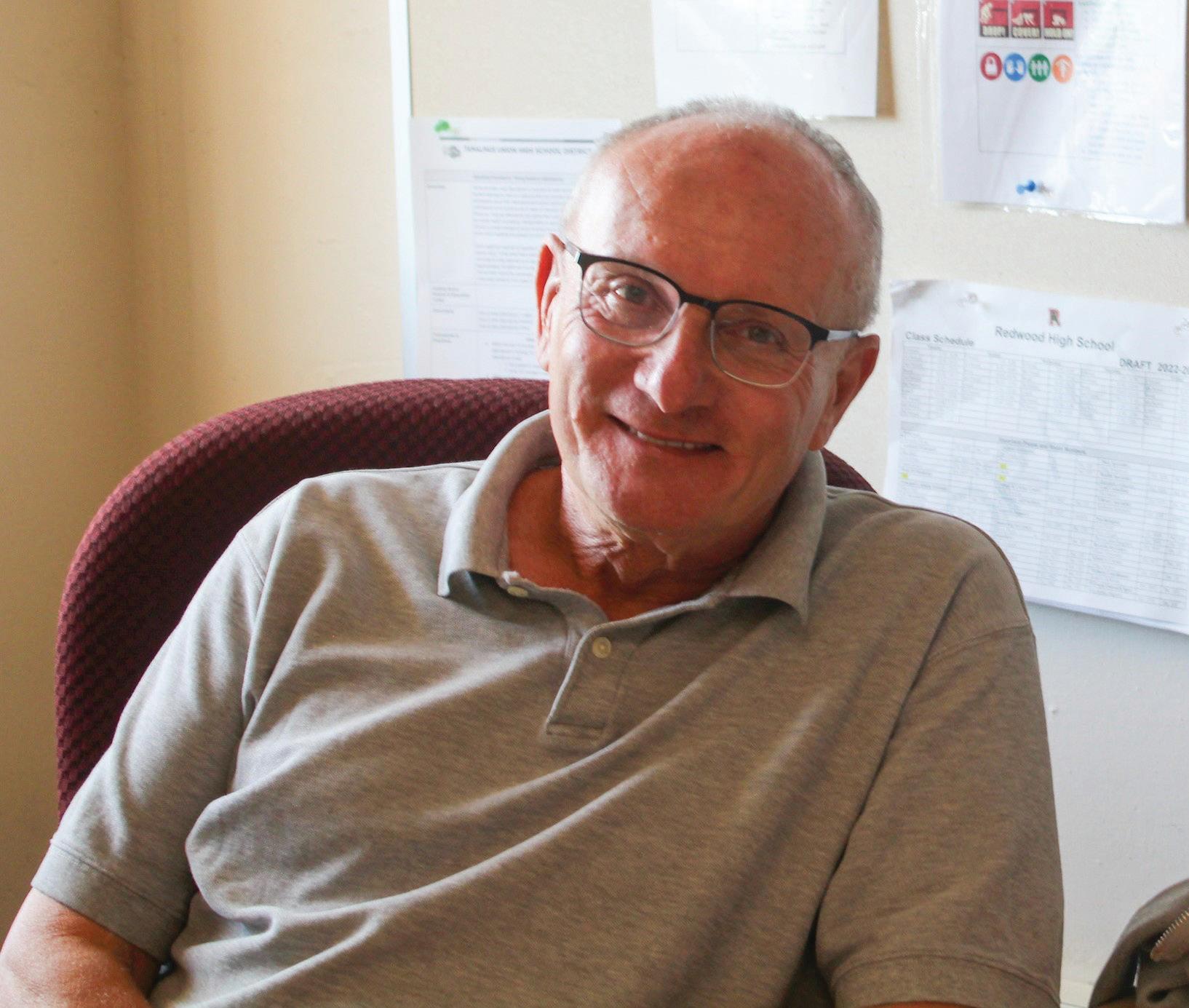
“[Being a substitute is] not as scary as people might think it is. Everyone thinks I’m crazy for being a sub and just walking into an unknown situation. But for the most part, the kids are pretty respectful. And I try to be very kind and show them respect. It’s not an exact science, but they show respect back and we get through the period doing whatever needs to be done,” Tribolet said.
kdeforrest@redwoodbark.org
Shining a light on first generation college students
By Alexandrea Coe
As students do their best to balance school work, college applications, extracurriculars and social events, avoiding stress becomes nearly impossible. This time of the year can become especially difficult to find which school is the “perfect fit” when you are the first in your family to apply or attend college. Having limited guidance from one’s parents on the college experience can make the application process that much more stressful. According to an October 2022 Bark survey, seven percent of Redwood students consider themselves to be first generation college students, meaning that they are the first in the family to apply to, attend and graduate college.
Senior Emily Sisuphan is a future first generation college student and addresses some of the struggles that come with having to learn to filter through the advice being thrown at her.
“[Since] I can’t rely on my parents for information on the college application process, I would say that 80 percent of my knowledge about schools comes from my peers, which I know is not always the most reliable source [of guidance],” Sisuphan said. “There is so much information [about colleges] that is being presented so fast. I try to act like a sponge but it’s so hard to absorb [all the advice] that I need to know without drowning.”
Sisuphan stresses how her feelings of being overwhelmed are often intensified by her family’s lack of perspective on the college experience. While a family member’s personal experiences may not be as credible as a college counselor’s advice, they can still be beneficial to students.

Music enthusiast and senior Rachelle Belanger relates to such hardships, being the first in her family to apply to and ultimately attend college. Her parents were born in Thailand and have a limited understanding of the American college application process, Belanger feelsdisadvantaged. As she currently tackles the college application process alongside her peers, she emphasizes the frustrating misconceptions people hold.
“My peers and teachers just assume that I understand everything. In fact, I’ve had teachers get frustrated at me over knowing so little about what Advanced Placement courses were or how to register for the SAT. I wish people had more patience for first generation students like myself. People forget [that] we are quite literally teaching
ourselves everything,” Belanger said. “However, I am very grateful for the College and Career Center [at Redwood].”
Becky Bjursten, the College and Career Center Specialist, highlights the importance of knowing what resources are available at Redwood. Open daily, this center helps students with financial aid applications and personal statement edits.
“College can be affordable and accessible. It truly just comes down to the support available to get students there. [For first generation college] students who have limited guidance to their peers, knowing what resources are available is crucial for success during the college application process,” Bjursten said.
While the College and Career Center does its best to make the college process more straightforward and manageable, the stress and pressure to attend any four-
year institution is very apparent at Redwood. Sisuphan’s journey of needing to set the precedent for her younger sister to go to college and follow in her footsteps, adds a whole new layer of pressure.
“Being the first child to apply [to] and attend college makes the process a lot harder compared to my peers who have their parents to guide them. While I recognize that I have many resources available to guide me, it’s just a setback that carries heavy impacts. I have to act as the parent for my younger sister, setting the precedent and path for her to walk down more easily when she reaches her senior year,” Sisuphan said.
From a professional standpoint, Bjursten references the common pressures she witnesses in her line of work with both first generation and legacy students. She addresses that Redwood’s competitive nature does not help students de-stress either.

“From what I have noticed, when you are the first in your family [to attend college], [you face] an internal pressure. You want to succeed in representing your family well, and setting the path for future generations,” Bjursten said. “The pressures are everywhere, and it can be very discouraging.”
When it comes to feeling discouraged, Sisuphan conveys how easy it is to feel self conscious about one’s ability to succeed when your peers are so much more advantaged than yourself. She offers advice to students in a similar position ot herself.
“Trust me, I know it’s hard asking for help. I know it’s scary to admit to yourself and others that you are disadvantaged from a lot of your peers,” Sisuphan said. “At first I was even embarrassed [being a first generation student], however, as of right now, while I am not to the point where I am fully proud of it, I am more comfortable with it. My biggest piece of advice [to any other first generation college student] is truly to be the best selfadvocate you can be, and to get as much help as you can. Get help the moment you need it and don’t forget [that] the services and people available to you are here for the larger purpose of helping you reach your goals.”
HAVING TAUGHT AT Redwood, Hall, Neil Cummins and the Cove, Lisa Tribolet finds that substitute teaching is not as scary as one might think.
Photo courtesy of Lisa Tribolet
RETIRING AT THE end of this month, substitute and former teacher Gary DeTore has been working at Redwood for the past 30 years.
Photo by Kate DeForrest
acoe@redwoodbark.org
barkwww.redwoodbark.org Page 23 • Lifestyles
Corinne Hunt breaks barriers
Taking part in Boy Scouts of America
By Coco Boyden
Since she was 13 years old, senior Corinne Hunt has been a part of Boy Scouts of America (BSA), an organization founded in 1910. Created for the purpose of preparing boys to enter the military, this program teaches crucial life skills, ranging from self-confidence to leadership, and promotes academic merit, hard work and honesty.
In BSA, there are many troops someone can become a part of, depending on where they live. Marin has troops in Mill Valley, Tiburon, Larkspur and Corte Madera. Hunt is a member and one of the few founders of Troop One Girls, located in Mill Valley.
“In order to create a troop, you have to have things like adult leadership, funding, roles and structure. So, me and a couple other girls pounced on the opportunity to create our own troop in March of 2019,” Hunt said.
It wasn’t until January 2019 that women were allowed to be in Boy Scouts; there are few girls in the program today as a result. However, BSA has approximately 2.2 million youth members across the nation, as well as 35 million adult volunteers who help carry out the BSA’s mission. The work of these adult members is critical, as they keep the program running and organized. Adult member Lisa Gilmore has been a part of the
scouts program for 16 years and has been with Hunt throughout her BSA journey.
“Ever since girls were able to join BSA, I’ve gone from the back end of things, which is more [about] organization stuff, to now running the troop with the Scoutmaster. This was when I first met Corinne, and she was one of the first girls at the interest meeting and she is so close to reaching Eagle Scout,” Gilmore said.
Once Hunt reaches Eagle she will join the 2.5 percent of all women eagle scouts compared to the 97.5 percent of men who have reached Eagle scout. Through years of being one of the few girls in boy scouts, Hunt has had time to reflect on being often the only girl in many rooms.
“Being one of the few girls in a maledominated organization [has] been very eye-opening. I have noticed a lot of times where my input has been blatantly ignored,” Hunt said. “It’s not to say that these people are bad people, I just think they have a lot of doubts about having a girl in their organization. I’ve also been the only girl in a lot of rooms and I’ve often felt really out of place.”
Her feelings of estrangement, however, did not stop her from pursuing her passions and goals as a Scout. Among other things, her love for the outdoors — influenced by her grandfather, Doug Singer — originally inspired her to join BSA and motivated her to stay.

“My grandfather is a huge inspiration of mine. I have always strived to make him proud. I wanted to carry over his and my newfound love for nature, and joining Scouts seemed like the perfect opportunity for that,” Hunt said.
Singer served in the Vietnam War from June 1964 until December 1968, and credits that experience as a strong influence on the rest of his life. He has passed on important values he learned during those years to Hunt, that she has taken with her throughout her life.
“I’ve taught Corinne what she ought to know about the outdoors; however, the values and important lessons I’ve learned throughout my life are most important: Do not lie, speak your mind and understand authority, but do not be scared to challenge it,” Singer said.
One of the main goals of being a scout is attempting to reach Eagle Scout, the highest rank possible. It often takes six years to become an Eagle, given the numerous necessary merit badges. Only around 5 percent of all Scouts ever reach this status, and Hunt is just one step away.
“I’m not officially Eagle because I have to go through and submit my Eagle letter of intention and get past my board of review. One of the many things we need to do to get Eagle is to complete a service project that benefits the community. For my project, I created 600 handmade fabric bibs in commemoration for the 100th anniversary of the first women’s hike,” Hunt said.
Her grandfather knows the time and work that Hunt has put in for almost six years to achieve Eagle and views this as more than just reaching the highest rank.
“I think that achieving the status of Eagle Scout is important because it indicates that the individual who is trying to achieve that status has had to commit to do a whole series of things along the way, all of which [build] character in one way or another. And that is very important in life,” Singer said.
With minimal representation of women in the BSA, they are constantly looking for new members. If you range from the ages 11-18 and think you’d be interested in becoming a Boy Scout, look up Boy Scouts of America and sign up on their website.
Photo courtesy of Corinne Hunt

 Photo by Aanika Sawhney
Photo by Aanika Sawhney























 jfrankus@redwoodbark.org
jfrankus@redwoodbark.org








 Por Andre García
Por Andre García
 Por Pía Kaltreider y Mía Johnson
Por Pía Kaltreider y Mía Johnson




 By Sam Kimball
By Sam Kimball















 brivera@redwoodbark.org
brivera@redwoodbark.org




 By Maddie Sofnas
By Maddie Sofnas




 By Lauren Poulin
By Lauren Poulin





